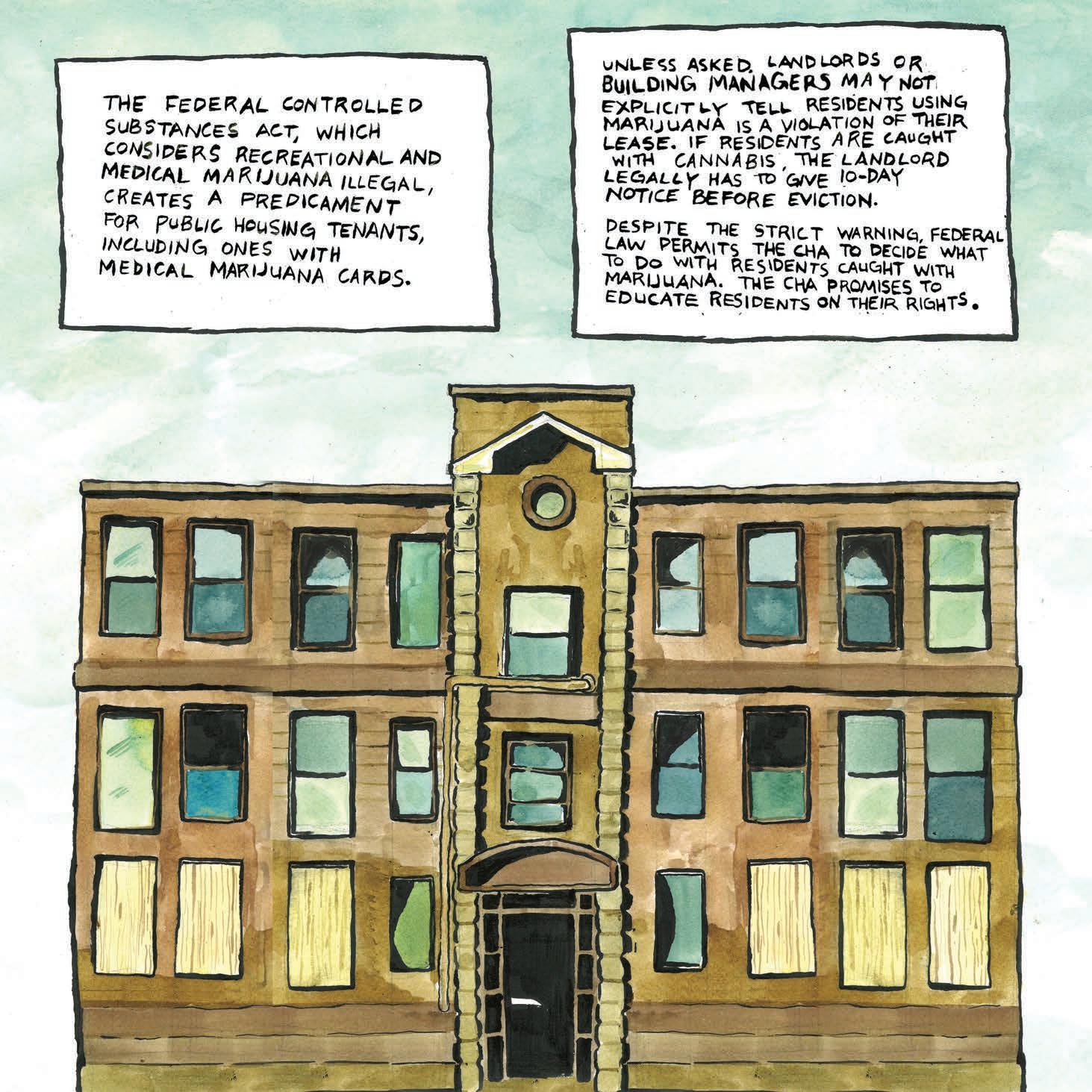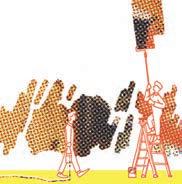Weedman’s not worried


What legal cannabis means to a dealer, a stoner caramel corn recipe, and other tales to take you into 2020 CHICAGO’S FREE WEEKLY SINCE 1971 | DECEMBER 26 –JANUARY 2, 2019
CITY LIFE
08 Comic What federal law means for some Chicago residents who want to smoke pot
10 Dukmasova | Feature Illinois’s cannabis legalization may be designed to put dealers out of business, but their business is about more than just selling weed.


ARTS & CULTURE
22 Visual Art “Restrain” appears static, but the works (and the viewers) dance.

THEATER
03 Sightseeing A sheriff, a pack of journalists, and three sergeants walked into a field of weed . . . with flamethrowers.
FOOD & DRINK
05 Recipe How to make cannabis caramel corn

19 Communing Even with legalization on the horizon, these women of color feel safest creating spaces for weed-infused activities on their own terms.
21 Law The dos and don’ts of adultuse cannabis in Illinois
23 Review Dance Nation captures the authenticity and vulnerability of adolescence.
24 Picks Cure the wintertime blues with these hot January options in performing arts.
27 Movies of note Cats is a towering achievement in furry porn; Greta Gerwig’s adaptation of Little Women is a beautiful masterpiece.

MUSIC & NIGHTLIFE
28 In Rotation Current musical obsessions of drummer Tim Daisy, cellist Lia Kohl, and Reader music editor Philip Montoro
29 Shows of note Sleep, Renaldo Domino, Blake Saint David, and more this week
34 Early Warnings Chris Farren, Yundi Li, Taj Mahal Quartet, and more just-announced concerts.
34 Gossip Wolf Chloe the punkscene pug crosses the rainbow bridge, online ecology publication Mid Magazine launches with an Ariel Zetina mix, and more.
OPINION
36 Savage Love Dan Savage offers advice to people considering opening their relationship.
CLASSIFIEDS
Jobs
NEWS & POLITICS
06 Joravsky | Politics Mayor Lightfoot’s cannabis cultivation center—finally, a TIF expenditure that makes sense.
 LETTER FROM A DESIGNER
LETTER FROM A DESIGNER
Versions of Sue

THESE ARE THREE versions of me: at the beginning, middle, and end of my time at the Reader . Long-hair-don’t-care, doe-eyed and hopeful; accomplished and arrogant; established and at peace. On any given week, depending on my responsibilities, I have been any one of these. It’s been an honor to shape the visual identities of the Reader —CREATIVE LEAD SUE KWONG, WHOSE LAST DAY AT THE READER WAS DECEMBER 20
FILM
25 Reviews The script is sometimes wanting, but Star Wars: The Rise of Skywalker is a fun conclusion to the movie saga; Pedro Almodóvar strips away emotional facades in Pain and Glory.
Marketplace
ON THE COVER: ILLUSTRATION BY FRANK OKAY. FOR MORE OF OKAY’S WORK, GO TO FRANKOKAY.COM.
TO CONTACT ANY READER EMPLOYEE, E-MAIL: (FIRST INITIAL)(LAST NAME) @CHICAGOREADER.COM
PUBLISHER TRACY BAIM EDITORS IN CHIEF SUJAY KUMAR, KAREN HAWKINS CREATIVE LEADS SUE KWONG, RACHEL HAWLEY
MUSIC EDITOR PHILIP MONTORO
THEATER AND DANCE EDITOR KERRY REID CULTURE EDITOR BRIANNA WELLEN ASSOCIATE EDITOR JAMIE LUDWIG
SENIOR WRITERS DEANNA ISAACS, BEN JORAVSKY, MIKE SULA
STAFF WRITERS MAYA DUKMASOVA, LEOR GALIL
EDITORIAL ASSOCIATE S. NICOLE LANE
LISTINGS COORDINATOR SALEM COLLO-JULIN CONTRIBUTORS ED BLAIR, NOAH BERLATSKY, LUCA CIMARUSTI, MARISSA DE LA CERDA, MARI COHEN, JOSH FLANDERS, SHERI FLANDERS, JACK HELBIG, IRENE HSAIO, CATALINA MARIA JOHNSON, MONICA KENDRICK, STEVE KRAKOW, NOËLLE D. LILLEY, JAMIE LUDWIG, MAX MALLER, ADAM MULLINS-KHATIB, J.R. NELSON, JEFF NICHOLS, MARISSA OBERLANDER, MATTHEW SIGUR, CATEY SULLIVAN
DIRECTOR OF DIGITAL JOHN DUNLEVY DIRECTOR OF PUBLIC ENGAGEMENT & PROGRAMS KRISTEN KAZA
SOCIAL MEDIA COORDINATOR JANAYA GREENE MEDIA PARTNERSHIPS COORDINATOR YAZMIN DOMINGUEZ
ADMINISTRATIVE ASSISTANT TARYN ALLEN ADVERTISING
312-392-2970, DISPLAY-ADS@CHICAGOREADER.COM CLASSIFIEDS: TALLEN@CHICAGOREADERCORP.COM
SALES DIRECTOR PATTI FLYNN
VICE PRESIDENT OF SALES AMY MATHENY CLIENT RELATIONSHIP MANAGER TED PIEKARZ SENIOR ACCOUNT REPRESENTATIVES LENI MANAA-HOPPENWORTH, LISA SOLOMON CLASSIFIED SALES MANAGER WILL ROGERS
NATIONAL ADVERTISING VOICE MEDIA GROUP 1-888-278-9866
VMGADVERTISING.COM
JOE LARKIN AND SUE BELAIR
DISTRIBUTION CONCERNS distributionissues@chicagoreader.com 312-392-2970
STM READER, LLC
BOARD PRESIDENT DOROTHY R. LEAVELL TREASURER EILEEN RHODES SECRETARY JESSICA STITES AT-LARGE SLADJANA VUCKOVIC
CONSULTANT CAROL E. BELL
READER (ISSN 1096-6919) IS PUBLISHED WEEKLY BY STM READER, LLC 2930 S. MICHIGAN, SUITE 102 CHICAGO, IL 60616 312-392-2934, CHICAGOREADER.COM
COPYRIGHT © 2019 CHICAGO READER PERIODICAL POSTAGE PAID AT CHICAGO, IL
ALL RIGHTS RESERVED. CHICAGO READER, READER, AND REVERSED R: REGISTERED TRADEMARKS ®
2 CHICAGO READER - DECEMBER 26, 2019 ll
38
39
THIS WEEK CHICAGO READER | DECEMBER 26 2019 – JANUARY 2, 2020 | VOLUME 49, NUMBER 13
IN THIS ISSUE
ANNA GRACE NOLIN
SIGHTSEEING
When Cook County enlisted the Marines to fight marijuana
A sheriff, a pack of journalists, and three sergeants walked into a field of weed . . . with flamethrowers.
 By JEFF NICHOLS
By JEFF NICHOLS
On July 15, 1957, officers from the Cook County Sheri ’s o ce, a squad of journalists, and three U.S. Marine sergeants arrived at the banks of the Chicago Sanitary and Ship Canal near Route 83, northeast of Lemont. The Marines were veterans of the Korean War, including one of nine survivors of a 32-man combat team.
Under the watch of Sheriff Joseph D. Lohman, the Marines used flamethrowers to torch a field of marijuana, some of which was growing over eight feet tall. “Marijuana is a weed and spreads like crabgrass once it goes to seed,” intoned the narrator of the Universal Newsreel that captured the event. The three Marines “live up to the Corps’s boast. They have the situation well at hand!”


Watching Sheri Lohman perform for the newsreel camera, it might be easy to imagine
him as a goo all machine hack. He was, in actuality, a nationally respected lecturer in sociology at the University of Chicago. Running as a Democrat in 1954, he didn’t campaign for sheriff as an antidrug warrior, but as a criminologist who could take on the problems of gambling and juvenile delinquency and professionally manage the county jail. Also in Lohman’s resume was his work with the United Nations, repatriating prisoners of war at the end of the Korean War.
His campaign survived a major hit after Governor William Stratton released a tape in which a speaker, who sounded a lot like Lohman, mused, “Did you ever know that police officers have a disproportionately high number of wives that were formerly prostitutes?” Lohman claimed that the tape—in which the speaker also suggested that “a prostitute who hasn’t really
DECEMBER 26, 2019 - CHICAGO READER 3 CITY LIFE
UNIVERSAL NEWSREEL, NATIONAL ARCHIVES-COLLEGE PARK
J
from 3



gone down the drain is one of the most sympathetic, understanding human beings that ever lived”—had somehow been spliced and manipulated in a “criminal hoax” and that the voice on the tape was not always his. After his election, the Tribune noted that Lohman’s principal duties involved managing “a big jail and a smallish police department.”
In the year Lohman was elected, there were 312 charges involving the sale of marijuana in Chicago. In contrast, there were more than 21,000 arrests for possession of cannabis in 2011, the year before the City Council passed an ordinance giving the police the option of issuing tickets for petty marijuana possession, according to the Sun-Times . In a 1955 U.S. Senate hearing, Joseph J. Healy, head of the Narcotics Bureau of the Chicago Police Department, loosely estimated there were 1,400 to 1,500 marijuana smokers in Chicago.
Nonetheless, law enforcement in Chicago was concerned about the increasing consumption of marijuana. Both Healy and Albert E. Aman, district supervisor of the Federal Bureau of Narcotics, admitted that they didn’t believe marijuana was addictive but expressed their belief that a large percentage of heroin addicts had “graduated” from cannabis use. Aman contended that “sex perversion and rape,” as well as other crimes, were commonly committed while under the influence of marijuana.
According to the Federal Bureau of Narcotics—a precursor to the Drug Enforcement Administration—the main supply of marijuana in Chicago came from Mexico. These imported strains were more potent than local ones. While authorities periodically came across the patches of marijuana cultivated in vacant lots, there was one corner of southwest Cook County that repeatedly came up in the press as a problem area. If you were to float down the Chicago Sanitary and Ship Canal from Willow Springs to the Calumet Sag Channel, then sail east along the Cal Sag west to Worth in the 1950s, you would be passing along the Golden Crescent of illicit marijuana cultivation in Cook County. Far from the eyes of suburbanites, farmers, and police officers, this undeveloped, unincorporated space was partially accessible by car.
The Sanitary District—now called the Metropolitan Water Reclamation District of Greater Chicago—oversaw both waterways. As early as 1941, the Sanitary District employed crews to cut down marijuana growing along its land. It also experimented with fire,
tractors, and herbicides to eradicate marijuana. Weed killers were applied by workers with hand-pump canisters and sprayers mounted on barges. On occasion, Sanitary District workers experienced sabotage: the lights of their trucks would be left on overnight to drain batteries and parts were removed from sprayers to make them inoperable.
After four weeks of undercover work involving deputies dressing as hobos, the Cook County Sheri ’s o ce arrested seven men in September 1949 for cultivating a 25-acre lot not far from the plot the Marines would torch in 1957. The accused men admitted that they sold joints for as much as 50 cents, roughly $5.35 when adjusted for inflation. Two years later, the Cook County Sheri ’s o ce supervised the cutting and burning of ten acres near Willow Springs—“[e]nough marijuana to supply half the south side,” in the words of the Tribune.
Only seven months after Lohman was elected, the Cook County Sheri ’s o ce announced that they had destroyed a four-mile strip of marijuana along the Cal Sag Channel. The space had been under surveillance for several months, but there was not enough manpower to case the entire area around the clock. Fearful that the crop would go to seed and spread in August, Lohman brought in Marines with flamethrowers to finish the job. The following year Lohman brought in a mobile land clearance saw and bulldozer to destroy another patch near the Cal Sag Channel.
In 1957, Lohman supervised a second torching of a marijuana field along the Sag Channel, this one running a mile long and 200 feet wide. Lohman gave fluctuating estimates of how many millions of dollars of marijuana he destroyed. But Lohman had ambitions beyond the Cook County Sheri ’s o ce. In 1958 he was elected state treasurer. His path to the governor’s o ce was blocked by Mayor Richard J. Daley, with whom he frequently clashed.
After Lohman’s departure, the Sanitary District continued its war on marijuana, albeit in a low-key fashion. In 1969, the State’s Attorney’s office destroyed a field growing near the confluence of the Chicago Sanitary and Ship Canal and the Cal Sag Channel. Harvesters had come from as far away as California and Washington, D.C., and included members of the Head Hunters Motorcycle gang. Times had changed from the afternoon in which Sheri Lohman and the Marines had “the situation well in hand.” v
@backwards_river
4 CHICAGO READER - DECEMBER 26, 2019 ll
CITY LIFE continued
150+ VENDORS 100+ SPEAKERS THE LARGEST CANNABIS INDUSTRY FOCUSED ON ILLINOIS! necann.com/2020-illinois Contact ads@chicagoreader.com or call 312-392-2970 APRIL 3-4, 2020 THE CHICAGO HILTON, IL I C C LLINOIS ANNABIS ONVENTION THE
Search the Reader’s

of thousands of Chicago-area restaurants at chicagoreader.com/food.
How to make cannabis caramel corn

Co-Op Sauce’s jefe offers a crackerjack update on the city’s oldest snack.
By MIKE SULA
When you smoke a joint, your lighter does this. When you’re making edibles, the process is a bit more complicated.
In this recipe, given the use of plant material (as opposed to isolates), the end result will smell and taste unmistakably of weed. If this isn’t your bag, you can minimize it somewhat by not grinding your flower too finely before you infuse it into your chosen fat.
There are a number of fancy gadgets you can buy that make the de-carbing and infusing process easier and faster, or you can use a slow cooker or sous vide for an odorless process. This stovetop method is as simple as it gets.

FOOD & DRINK
Cracker Jack o cially debuted at the World’s Columbian Exposition, but its founder (if not inventor) Frederick Rueckheim was hawking some form of the caramel corn-peanut snack mix on the streets of Chicago more than 20 years earlier, in 1871. Yes, Garrett Popcorn’s Garrett Mix—formerly known as the Chicago Mix—usually gets more credit, but debuting nearly a century and a half earlier makes Cracker Jack Chicago’s most enduring stoner snack; for stoners, sure, and now those about to be stoned.
Mike Bancroft, of Co-Op Sauce fame and Sauce and Bread Kitchen, is a Cracker Jack fan, though he was always disappointed with the prizes. For the past few years he and partner Anne Kostroski of Crumb Chicago have been conducting edibles R&D, scaling up and fine-tuning some of their recipes for the legal cannabis market, namely their Nutty Buddy Munchy Bar, and this more demographically representative caramel corn recipe update, with pepitas and hot-and-sour Tajin seasoning.
Co-Op is working with some aspiring equity cannabis licensees with the aim of, Bancroft says, “bringing back full circle some of the social justice aspects of what we like to do” (more about that in the future).
In the meantime, he offers this enhanced version for the home cook made with decarboxylated cannabis infused into butter or coconut oil. Decarboxylation is the process of gently heating cannabis flower to convert nonpsychoactive THCa into psychoactive THC.
Determining dosage is much trickier and less reliable, but there are plenty of online guides to dosing your own edibles that can help you roughly determine the amount of THC and/or CBD in the mix. In this case, half a stick of butter infused with a strain with an average 17 percent THC is going to yield a batch with an estimated total of about 162 mg THC.
That’s just an estimate, but in any case it’s going to be a lot for an all-out binge session. Take it slow, big shooter. This recipe o ers an exercise in moderation. Cracker Jack is a snack that’s inherently meant to be scarfed, but this one will fuck you up if you don’t practice restraint.
Lime Chili Munchy Jax Mike Bancro , Co-Op Sauce, Sauce and Bread Kitchen
Yield: Approximately 14 one-cup servings with about 12 mg THC each, based on a 17 percent strain.
1/8 ounce cannabis flower, or 1/4 ounce shake

1/2 cup (1 stick) salted butter, or coconut oil 12 cups popped popcorn (1 cup kernels)
1 cup light brown sugar (packed)
1/4 cup honey
1/4 teaspoon baking soda
2 tablespoons Tajin, or similar lime chili salt, divided
1/2 teaspoon maple extract
1 cup pepitas, toasted
Step 1. Decarb flower
Heat the oven to 225 degrees Fahrenheit.
Grind the cannabis with a coffee grinder, or by hand. Place the ground cannabis on a sheet tray lined with parchment. Cook for about 30 minutes. Remove the sheet tray from the oven and let it rest for at least 30 minutes.
Step 2. Extract cannabinoids
Melt the butter or coconut oil in a small saucepan and heat to around 200 degrees Fahrenheit (medium low heat), never boiling. Add the decarbed flower and stir until immersed. Gently simmer for at least two hours, and up to six hours, stirring regularly. Strain off the butter/ coconut oil through cheesecloth, squeezing every last drop from the flower.
Step 3. Make that mix
Heat the oven to 300 degrees Fahrenheit. Pop the popcorn. Using a stock pot large enough to hold all the ingredients, bring the strained butter/coconut oil, brown sugar, and honey to a simmer, stirring until golden brown, about six minutes.
Add the baking soda, half of the Tajin, and the maple extract and stir. Add the popcorn and pepitas to coat evenly. Spread the coated mixture on the same sheet tray and parchment, and place it in the oven for 15 to 20 minutes, mixing as needed to toast evenly.
Remove and add the remainder of the Tajin. Cool to room temperature. Break apart with your hands or keep the resulting clusters.
Store in an airtight container out of the light, away from kids and pets. The finished caramel corn will last at least a couple weeks. v
@MikeSula
DECEMBER 26, 2019 - CHICAGO READER 5
Elevating a Chicago standby MARK WIEDER / UNSPLASH
RECIPE
online database
CHICAGO FOR CHICAGOANS
NEWS & POLITICS
POLITICS
the
of
Founded in 1971,
have always been free, and have always centered Chicago. Help us to continue to curate



of the diverse and creative communities of this fabulous city.
Reefer sanity
Mayor Lightfoot’s cannabis cultivation center—finally, a TIF expenditure that makes sense.
 By BEN JORAVSKY
By BEN JORAVSKY
For the last decade or so, I’ve been waging what you might call a two-front journalistic war on TIFs and reefer. I’ve argued that one should be blown up and the other legal to smoke up.
Well, for a brief moment last week, these two fronts came together as Mayor Lori Lightfoot proposed creating the city’s first “cooperative cultivation center” funded with about $15 million from the tax increment financing program.
All right, finally a TIF expenditure even I can endorse!
OK, so I know what you’re thinking. You’re thinking . . .
One, how can a program intended to eradicate blight in low-income communities be used to cultivate marijuana?
And two, how can we afford to pay for a cooperative cultivation center when we don’t even have enough money to reopen the mental health clinics in poor, high-crime areas that Mayor Rahm cruelly closed in 2011?
To answer the second question first—we’re



not really broke. There’s always a million or two or three in the good old TIF banana stand.
As for the first question, the state’s TIF law is larded with so many loopholes that the mayor is free to spend TIF money on pretty much anything, anywhere.
That’s why, over the years, various mayors have gotten away with doing things like taking TIF money intended to build a hotel in the South Loop and using it to fix up Navy Pier, which, as I never tire of pointing out, is neither blighted nor a community.
Mayor Lightfoot announced her idea for a cultivation center as the reefer revolt heated up in the City Council.

That revolt—led by 28th Ward alderman Jason Ervin—erupted when it became apparent that none of the 11 dispensaries given the green light to sell marijuana on January 1 were owned by Black people.
This was painfully ironic as one of the most legitimate reasons for legalizing reefer was that the law against it was so unfairly enforced. People of every race smoked it. But basically, only Black people were busted for
6 CHICAGO READER - DECEMBER 26, 2019 ll
The cannabis cultivation center would give people of color access to the most lucrative part of the business.
A7NUBIS
The Chicago Reader is community-centered and community-supported. You are at
heart
this newspaper.
we
coverage
Your donation keeps the presses rolling. CHIP IN HERE: www.chicagoreader.com/members WANT TO DONATE VIA CHECK? Make checks payable to “Chicago Reader” and mail to Chicago Reader, Suite 102, 2930 S. Michigan Avenue, Chicago, IL 60616. Include your mailing address, phone, and email—and please indicate if you are okay with us thanking you by name in the paper.
it—as Mick Dumke and I first chronicled back in 2011 when we wrote the Grass Gap.
To sum things up . . .
The funding from TIF, the economic development program intended to benefit low-income communities, was largely going to rich white ones. And the law against marijuana was mainly enforced on Black people.
So white people got the economic development money and Black people got busted. And you wonder why so many Black people have left Chicago over the last 20 years.
Anyway, it was especially di cult for Black aldermen who came to realize that the main beneficiaries of ending the war on marijuana were people who had su ered no consequences from that war at all. Namely, rich white people.
It would be as though the government created a program to aid Vietnam vets and gave all the money to Donald Trump, one of our country’s most prominent draft dodgers.
Ervin mustered up enough council votes to threaten to pass an ordinance that would have delayed opening the recreational marijuana dispensaries until July.
That got everyone’s attention, as city and state o cials pointed out that they were depending on tax revenue from the sale of legal weed.
You know, it’s funny how these things work. For decades, when Black people were getting unfairly locked up for possessing weed, no one appeared to be in a hurry to do anything about it.
But as soon as some Black aldermen made a move that might have kept rich white people from being even richer? Man, all hell broke loose.
It was in the midst of the reefer revolt that Mayor Lightfoot trotted out her idea for the cultivation center.
“Lightfoot said up to $15 million generated by tax-increment financing could be used as seed money for the plan to open a ‘cooperative cultivation center’ that residents of color could ‘buy into’—either with a ‘modest cash investment’ or with ‘sweat equity,’” SunTimes writers Fran Spielman and Tom Schuba reported.
“This is a very, very expensive business to get involved with,” Lightfoot said. “The basics to be a cultivator requires about a $13 million to $15 million investment. There are not a lot of people that have that, particularly in a market that a lot of banks and traditional lenders won’t touch.”

“I think the only way to really crack this nut


NEWS & POLITICS
is for the city to invest its own resources to get engaged, get diverse entrepreneurs involved in the most lucrative part of the business, which is cultivation,” Lightfoot added.




Sounded like a good idea to me—so long as they put the cultivation center in an actual poor or blighted community. As opposed to sticking it someplace like Lincoln Park or Lincoln Yards.
Which, considering how things go in Chicago, is probably where they’d stick it.
Eventually the reefer revolt fizzled as some aldermen who said they were going to vote for the delay backed o . The measure calling for a delay wound up being defeated by a vote of 29-19.
Nonetheless, I’m hoping Mayor Lightfoot doesn’t give up on her idea for a cooperative cultivation center, even if the pressure has passed.


It could actually have some residual benefits for the very low-income communities the program was intended to help, as opposed to watching more TIF funds go up in smoke. v
@joravben
Receive
33W361

off any purchase of









for
with this coupon!
DECEMBER 26, 2019 - CHICAGO READER 7
Find hundreds of Readerrecommended restaurants, exclusive video features, and sign up for weekly news at chicagoreader.com/ food. Geneva store:
Roosevelt Rd. Geneva, IL 60185 Chicago store: 5316 N. Milwaukee Ave. Chicago, IL 60630 AMERICAN SCIENCE SURPLUS Last Chance for theWorld’s Greatest Gifts! Last Chance
theWorld’s Greatest Gifts!
$5
$25
Not valid with other offers. Expires 12/24/19. In store only. Limit (1) per customer. Wooden Catapult Kit $19.95 Zivko STEM Robot Kit $42.95 Collectible Star Wars Pint Glasses $12.50 Tesla Socks $9.65

8 CHICAGO READER - DECEMBER 26, 2019 ll

DECEMBER 26, 2019 - CHICAGO READER 9ll

10 CHICAGO READER - DECEMBER 26, 2019 ll
Weedman’s day
Illinois’s
 By MAYA DUKMASOVA
By MAYA DUKMASOVA
be designed to put dealers out of business,
just selling weed.
Weedman’s workday began as the sun set on a clear December day. He jumped behind the wheel of a nondescript vehicle to start the night’s deliveries: $60 baggies of dry cannabis flower containing an eighth of an ounce each of strains with names like Black Cherry Pie, Cheesy Rider, Wedding Cake, Zweet Inzanity, and Gelato #45; a Mason jar filled with $10 pre-rolled joints; $20 packs of THC-infused gummies, chocolate bars flavored with raspberry and Himalayan salt, and bottles of tinctures.
If you saw Weedman on the street, and

someone told you the guy sells weed, you wouldn’t be surprised. But you’d never pick him out of a crowd as the obvious dealer either. Dressed in a Bulls beanie and a pu er jacket, Weedman has a relaxed and confident manner. His sneakers hit the sidewalk at just the right pace. He’s a rare example of a man about midway through life’s journey who both projects total confidence and puts you at total ease. He leans Bob on the Jay-to-Silent-Bob spectrum. He is the opposite of creepy. He has the thoughtful, measured speech befitting a cannabis purveyor. When he says herb he pronounces the H.
His first customer was a white man in his
early 20s with scruffy hair and a beard who emerged from a courtyard apartment building in Lincoln Square and got into the back of the car. He wanted tinctures. These are liquid concentrates of THC: a few drops under the tongue can get you high faster than an edible and keep you high longer than a joint. It’s $60 for a 600 milligram bottle. “Can I spot two joints?” the man asked, drawling the vowels à la Keanu Reeves in Bill and Ted’s Excellent Adventure. Weedman obliged. The man was a regular, so they briefly chatted about Weedman’s upcoming holiday road trip to the south, and wished each other well as he exited.
Weedman wasn’t concerned that someone might notice the tra c in and out of his car and call the police. “I don’t think the cops would even entertain it,” he said. “I’ve had friends call 911 to get an ambulance sent over to them and they had to call three times because the cops didn’t believe them . . . there’s people getting killed in this city left and right.”
Weedman’s customers are more often women than men. Most of them are white-collar types. There are a few lawyers and a lot of teachers. Some work in media or advertising, others sell medical supplies. He once had a client who made sets for Sesame Street
The rhythmic sounds of Afro Medusa pulsed through the speakers as Weedman drove west. He pulled up next to an apartment building in Logan Square and parked in front of a fi re hydrant. “Cops in Chicago don’t give a shit about this,” he explained in response to my perplexed look as he exited. “What are they gonna do? Give you a ticket? That’s fi ne.”
Ten minutes later he settled back behind the wheel. He was amused that the customer’s parents were there, visiting from North Carolina. “His dad bought the weed for him. He was like ‘Ooh the Afghani, we’ll take that!’” Weedman said in a creaky voice imitating the older man.
“That’s one of the weirdest things I encounter. Americans are super casual about pot.
J
DECEMBER 26, 2019 - CHICAGO READER 11
FRANK OKAY PROFILES IN POT
cannabis legalization may
but their business is about more than
White American people. The Hispanics that buy weed in front of their parents—that’s very unusual.”



Weedman’s been running his underground cannabis delivery business since the early 2000s, selling dry bud and THC-infused products sourced from growers in Colorado, California, and the Pacific Northwest. His clients text or call him to order, and he usually swings by later the same day. The legalization of recreational cannabis in Illinois is meant to put guys like Weedman out of business. But he’s not worried. In fact, he predicts he’ll thrive and perhaps even attract new customers as more people feel comfortable with cannabis. He’s also banking on the loyalty of his customers, their commitment to what he represents. While some might appreciate the anonymous consumer experience of buying weed at one of Chicago’s dispensaries, Weedman’s services cultivate a human connection that the Walmartization of cannabis could never replace. A person’s relationship with their dealer is one of mutual trust and vulnerability and o ers as much of a respite from the grind of daily life as the intoxicating power of the herb itself.
Weedman’s longevity in the underground delivery business is unusual, according to him anyway. No city or state data o ers a statistical perspective on the prevalence of services like his or the frequency of such dealers’ apprehension by law enforcement, but Weedman’s seen many competitors come and go over the years. His place in the cannabis ecosystem is somewhere on par with artisanal co ee shops. He’s the $4 latte on the spectrum between Dunkin’ Donuts and owning your own espresso machine.
“There are businesses out there that are way more brazen than I am,” he said. “A lot of rich white kids in this game, they sell stu on Instagram.” These people tend to get caught for making stupid mistakes, he said, like flaunting their money in front of too many strangers. Meanwhile, street dealers work with lower-income clients and sell herb in packages as small as a gram, often sourced from Mexican cartels or other criminal organizations. “[Dealers] on the street usually buy from a guy who has an army of people,” he said, explaining that they often get caught because they’re working in neighborhoods oversaturated by police. These dealers’ supply chains also tend to be long and include a lot of middle men who may cut and mishandle the product. “With me, you’re probably one or two steps away, at most three
from the main source. In some cases you’re the third person touching [the weed]. It’s the grower, me, and then you.”

Weedman’s carved out a safer space for his work. He operates at the intersection of his own sound judgment and neighborhoods with sparser policing. He describes himself as “cruising like a mouse in a field, just moving along. Or moving under a ledge—nobody sees you, you’re just chilling, hiding in plain sight.” He stays o the Internet and keeps his business to strictly weed: “I’ve never sold anything to anybody to put up their nose.” He only works with customers referred by people he trusts. Weedman buys herb from growers at wholesale prices usually ranging from $1,000 to $2,500 per pound. Sometimes he gets it delivered through the mail. “It just needs to be packaged really well,” he said. “Just like any other smuggling it needs to be sealed and not stinky.” Other times, he or someone he trusts drives it from the western states.
“If I’m driving it I’m going for the gold,” he said, meaning he buys up to 40 pounds of dry cannabis flower at a time. The weed gets secreted away inside inconspicuous vehicles, but since the consequences of getting caught transporting it over state lines would be severe no matter the quantity, “I just take as much as I can drive.” He never buys more than he can afford, though. He’s seen people take out loans to buy enough product to fi ll a semi truck and then have trouble selling it all and paying back creditors. “A lot of bad stories with debt.”
If he’s driving with his supply, he has a plan for how to deal with the cops if he’s stopped: “Never be in a rush, that will save you eight times out of ten.” The second rule is to never talk to the cops. “If you’re being stopped doing what I’m doing, you’re already being caught,” he said. “Your best bet is just to shut the fuck up.”


Weedman smokes his own inventory and sometimes worries about getting pulled over and called out on smelling like weed—which cops in Illinois will still be allowed to use as probable cause for a vehicle search despite legalization. But he’s also got a medical marijuana card and, if questioned, he’d just admit that yes, he had recently smoked. (Determining cannabis intoxication is notoriously di cult, but, according to the Chicago Police Department, no new field sobriety tests for figuring out if someone is high have been added to the existing DUI investigation protocol.) If he’s pulled over with his daily delivery supply, Weedman has a lockbox to throw his stash into. He’d refuse to open it if asked. “They

12 CHICAGO READER - DECEMBER 26, 2019 ll
JANUARY 14 - 25, 2020 KENNEDY-KING COLLEGE 740 WEST 63 STREET www.collaboraction.org FOR TICKETS & MORE INFORMATION STUDENT, SENIOR & GROUP DISCOUNTS AVAILABLE
"This is the most healing form of activism that I have seen in my life." -GQ, The Q Brothers RD
continued from 11
can’t make me open it without a warrant,” he said. “And I would be ready to go to jail over not answering cops. They’d have to book me for who knows what, come up with a crime for me on the spot—they would have a hard time getting into that box.” Weedman has a lawyer. He declined to comment on whether he’d ever been busted before.
Weedman avoids texting too many details and talking too explicitly on the phone. His competitors often work with menus and when


clients text, the dealers send back a list of what’s available. Customers have to make specific orders and then get only whatever they asked for delivered. Weedman operates more like the Avon lady and brings his entire day’s supply to every customer to let them peruse in person.

“People will be psyched about the dispensaries, but then I think people will call me back,” Weedman said. “Because of the prices.” At $60 for an eighth of herb, his prices are on par with what dispensaries charge for medical cannabis, but he’s sure that recreational pot will be more expensive—especially because demand will soar and supply will be limited. The state has warned that recreational dispensaries will run out of product quickly in the new year.
Since the dispensaries will only be able to sell pot grown in Illinois and it takes a few months for a plant to mature and produce optimal bud, Weedman will be there to fi ll the void with his fully operational year-round supply chain. He’s been getting ready for months, “just stacking [one-pound] units, waiting for the dry spell.” He predicts that the recreational dispensaries will be “more for the guy who comes from Indiana with his friends.” Plus, he has a satisfaction guarantee. If someone fi nds something wrong with his product, or even
just doesn’t like the taste, he’ll replace it for free. Even if the customer has already eaten all the gummies or smoked all the herb.
Another edge he’ll have on the dispensaries is that he’s able to sell much more potent products in larger quantities than will be permitted under the new Illinois law. While he can sell you as many $40 chocolate bars with 200 mg of THC each as you’d like, the dispensaries will only be able to sell 500 mg of edibles at a time. For people dealing with chronic pain, this is a crucial di erence. One of his customers, for example, buys six chocolate bars every two weeks. “He says some days he eats a whole bar,” Weedman said. “Some people su er from a lot of pain.”
Not all of Weedman’s customers are medicinal users though. Younger people buy more for the fun of getting high, while “the older ones— it’s their beer at night.” Many of his clients are “nine-to-fivers” and “office people stuck in cubicles.” Like him, they often turn to weed to unwind after a long day at work. “I like pot because it helps me relax,” he said as we drove south on Western to his next delivery. “Just the stupid stress that the city puts on you—it helps a lot with that.”
Weedman was born and raised in South America (but didn’t want to reveal which country). He grew up as a “latchkey kid” with a strict mom. Where he’s from, weed wasn’t seen as a harmless indulgence but as a hardcore drug, on par with cocaine, heroin, and the rest of it. “Pot was a big no-no for me.”
Still, teenage Weedman did try smoking once. He and a friend bought some herb, which “was all super shwaggy and dry.” They were rolling a joint behind a bush in a public park when a man pulled a gun on them and told them they were breaking the law. (Turned out he was a neighborhood watch vigilante, not an actual cop.) Weedman and his friend ran away, then smoked the joint. “I was so nervous I didn’t even feel anything, but my friend got sick,” Weedman said. They went to a local clinic, where a doctor brought in a gaggle of medical residents and used the stoned friend “as an example of what happens to people on drugs.” Young Weedman was freaked out.
He didn’t get back to pot until he came to America after high school to live with family in the southwest. He went to a community college where he first met “real” stoners who showed him that smoking weed was as much a culture as it was a fun way to
DECEMBER 26, 2019 - CHICAGO READER 13
“I’ve smoked pre-rolls all over this country, and I’ve paid top dollar for them. But to me, mine are the best. Mine are all flower.”
—Weedman J

14 CHICAGO READER - DECEMBER 26, 2019 ll
temporarily mess with brain chemistry. Weedman dug the culture. “That’s when I started learning about Cypress Hill,” he recalled. “I was into Rage Against the Machine too. And I realized that it was on the left side of things, smoking pot.” Since the cops and other representatives of power and authority hate weed, he thought, there must be something inherently radical about it. “To this day I think it’s like a revolutionary thing to do.”
In the late 1990s, Weedman came to Chicago. For a while, he was a ramp worker for a major airline and also tried to start his own business. One day he met a man who ran a weed delivery service in New York City. Weedman fi gured he’d try supplementing his income by creating something similar in Chicago.


Procuring the wholesale supply at the time turned out to be a nightmare. “It was way out in the burbs and it was such an ordeal to get this weed and it ended up being super shitty weed,” he recalled. “I bought my fi rst ounce of weed and it must have taken me a whole month to get rid of it,” he said. “I didn’t know that many people.” The stress of juggling three jobs was getting to him; his legal business faltered and he was eventually fi red from the airport. “I was trying to hug too many things at once,” he said. “You can only hug one person at a time properly.”
Weedman got deeper into the weed business. He heard stories about the wonderful world of cannabis cultivation in Colorado and slowly connected with high-quality suppliers there. At fi rst he rolled all the joints, packaged the flower, baked brownies, and made all the deliveries himself. He started out making a couple hundred dollars a week (“That was awesome”), then $500, then $1,000. Eventually he realized he couldn’t handle it all on his own and brought in some trustworthy friends to help. Weedman’s modest empire has grown to nearly 300 customers, most of whom are friends of friends of friends of friends. In a good year he now easily makes six fi gures. He said he’s poured much of his proceeds into retirement savings and health insurance costs, and also to help capitalize his legitimate gig, which now employs half a dozen people.
Weedman spends a typical day grinding at his day job, managing the mundane affairs of a small business. Most weed deliveries happen after hours, though some customers who work in restaurants like to buy in the mornings. He collects orders by noon so he can plan a route that’ll land him closer to home by the end of the
night, usually around 11 PM.
The night I tagged along was unusually slow, just five scheduled drops. To kill some time, we stopped at Weedman’s legit business. Three of his employees were drinking beer and chatting with customers who seemed at home and lingered long after they finished what they came there to do. One of the guys who works in this business is also one of Weedman’s partners in the delivery business. He’s got a round face, short beard, and easy laugh. His client base is still small, only about 20 people, because he got “spooked.” Not long ago he was doing lunchtime weed delivery to o ce buildings, alongside delivering food through an app. A security guard in a Loop skyscraper searched him and found the weed and threatened to call the cops if he didn’t hand it over. Weedman Jr. lost an ounce of herb on that day.
The three of us talked in the back of the establishment. (Weedman’s casual about discussing the “dog walking” business here; his other employees know about it.) He’s proud of how he’s distinguished himself in the delivery game, even through small touches like the design of his inventory. The gummies, which contain 10 mg of THC each and come in packets of ten, are shaped like tiny monkeys, penguins, and lions. He opts for stiff brown paper pouches to sell the flower, with brightly colored stickers indicating the name of the strain. And he’s generous when he stu s them, often putting in a bit more than the 3.5 grams equivalent to an eighth of an ounce. “My bags are fat,” Weedman said.
I asked how they make the pre-rolled joints, which are perfect cones packed tightly from filter to tip and twisted shut on the ends. Weedman pulled up a YouTube video on a dusty computer monitor. It showed a man’s meaty hands loading dozens of empty Raw brand rolling paper cones into a beehive-like machine. The man’s voice was matter-of-fact, and gallon-sized freezer bags of bud littered his work surface. “This guy’s doing a shitty job,” Weedman said as we watched the man using a co ee grinder to pulverize the delicate herb into dust. Weedman uses a hand-cranked grinder the size of a five-gallon bucket, which breaks the dry bud into more delicate chunks. “I’ve smoked pre-rolls all over this country, and I’ve paid top dollar for them,” Weedman said. “But to me, mine are the best. Mine are all flower.”
Weedman tries to stock only organic strains grown in the sun or in controlled indoor environments. (He spoke at length about the virtues of outdoor-grown versus greenhouse-grown versus indoor-grown
Less scrolling.





More strumming.






DECEMBER 26, 2019 - CHICAGO READER 15
Anyone can play! Find your summer class at oldtownschool.org
Give your digital life a break. Connect over music, dance & more.
J continued from 13

16 CHICAGO READER - DECEMBER 26, 2019 ll

DECEMBER 26, 2019 - CHICAGO READER 17ll
pot.) His dry flower is carefully selected for potency and flavor and is “at most four months old from when you harvest it.” Weedman’s best-selling strains are indicas (which tend to relax and bring on drowsiness and the munchies) and “hybrids,” which are crosses between indicas and sativas (which tend to deliver a more heady, euphoric high).
Weedman predicts that legalization will make weed like craft beer. “I think there’ll be guys famous for the joints they roll—you want a joint shaped like a turkey for the holidays? There you go.” But he’s confident that the
quality of his products will outshine what’s sold at the dispensaries. Plus, some customers will surely keep buying from him for political and philosophical reasons, as well as cost and convenience considerations. Many pot smokers who have long been into weed culture have no interest in supporting a state that criminalized them and their friends for decades and now aims to shore up its budget with tax revenue generated in businesses owned by rich white men.
Ultimately, Weedman wants to cut down his supply chain even more by growing his own strains “to have my own brand.” As he’s been dabbling in cultivation he’s learning that it’s “not rocket science” as long as you’ve got good seeds and the right conditions. “If you make the conditions of prehistoric times then your bud is gonna be strong and powerful.” It takes “a lot of CO2. When these plants were evolving that’s what the environment was like.” He seemed to notice me making mental calculations about what was going on in prehistoric times. “Dinosaur weed,” he said, his lips dissolving into a grin.
“Ienjoy doing it,” Weedman said of his work as the car rolled east toward Ukrainian Village and the last of the night’s deliveries. “Ninety-nine percent of the people I’ve met doing this are just awesome people. Family people. They just love to smoke pot.” Most of his customers are white, perhaps because he lives mostly among white people. Weedman’s fine with it, though. “White people are chill, they’re never trying to find a deal,” he said. In his experience, people of color and immigrants like him love to haggle. (Weedman is the kind of guy who manages not to sound harsh even when he’s saying something judgmental.) “White people don’t haggle. I’m open to haggling but as long as it’s something reasonable—I can give you a better deal if you buy more.” He has a lot of south Asian customers. “Doctors. They like to haggle and they have money too. They’re rolling up in BMWs and Mercedes.”
Younger customers and first-time buyers can be shifty and nervous and in a rush. They don’t appreciate the romance of the weed deal, Weedman said. “Young people I don’t always groove with . . . But they usually don’t stick with me anyway because I’m not on their schedule. They want the Uber.” The on-demand commodification of almost every service has taken personal rapport out of drug dealing as much as any other business. But

Weedman is old school. He doesn’t accept tips. He likes to “slow the roll” when he’s with customers, to ask them about stu he sees in their home or how their day has been, to talk about Bernie Sanders, or breakups, or the Beatles for a spell.
Weedman treats each delivery like a visit with an acquaintance and not just a transaction, even though sometimes stepping into someone’s home can be unpleasant, especially if people hoard or don’t clean. “I’ve met a lot of gross people,” he said.
Sometimes, a relationship with a client fosters a deeper connection, even friendship. The next delivery is to a longtime customer who didn’t mind me accompanying Weedman into her home. A blond woman in her 30s with a bubbly voice, she welcomed us into her cozy living room wearing slippers and loungewear. Weedman opened his bag on the couch and pulled out a heavy-duty ziplock pouch full of herb packets. She described herself as a “really seasoned pot smoker,” and was relieved to fi nd Weedman after moving here from Los Angeles where she’d been used to “really bougie” weed culture. She decides what strain to consume depending on her mood or the tasks at hand. “I do like a sativa when I need to clean my house,” she said. “A sativa edible and my house will be sparkling clean!” Weedman laughed and noted that people rarely buy sativa, which makes many paranoid. “I have a five-star review for this guy,” she said as we prepared to leave. “He always comes through for me.”
“My thing has always been just show up with some weed, that’s the reason I’ve been successful,” Weedman said. “I always come. The moment you don’t, someone else will.”
The last customer of the evening was running late, and Weedman parked his car in front of the man’s building in Ravenswood to wait. He used the lull to spark up a joint, one of his own pre-rolls kept in a long plastic canister in the center console. His tinted windows were shut and as he puffed, the vehicle fogged up with fragrant smoke. “It’s romantic,” he said, referring to joints, his favorite way to consume herb. “It’s nice to sit and grind the weed and smell it and have your own joint. It’s an event, it’s not just smoking weed out of a bowl. But hey,” he added, chuckling, “as long as you’re smoking weed it’s all good.”
We talked about music. Weedman loves punk and salsa—some of which is quite punk, he argued, and put on a Henry Fiol track to demonstrate. We talked about relationships, his decision not to have children, the di cul-
ties of immigration. He still wants to go back to his home country one day, but, as the years go by, he fi nds it harder and harder to be comfortable there. The longer you live somewhere else, the more the place you’re from changes beyond recognition, “and you become a gringo too.”
This work has kept him grounded, though. His relationship with customers is based on a shared secret and on trust. Every transaction is an act of faith: he puts himself at risk being a dealer, but so do they, in welcoming a dealer into their homes. “You get to know people, you become friends with their pets,” he said, smiling through the cloud of smoke. He learns their tastes, the kind of art and music they enjoy, the ups and downs of their lives. Weedman’s sort of like a therapist. But even though he’s performing emotional labor, in the original sense of the term, it doesn’t weigh too heavily on him. “It’s mostly them telling me about their life and me, I’ll say stuff about myself that applies to what they’re talking about. I like to hype people up. If you’re having a shitty day and I can see it in your face, I’ll just tell you something to get you better.” Weedman’s happy to be part of customers’ self-care routine, to be a person they look forward to seeing and who connects them with something that brings joy and relaxation to their lives.
When the customer he’d been waiting for came home, Weedman went up to his apartment for the sale. He came back five minutes later. “Easy peasy,” he said. “There’s a cool kitty in there. This guy lets the cat pick his weed.”
The haze of the hotboxed car began to dissipate, and Weedman prepared to head home, looking forward to a hot dinner with his girlfriend and probably another joint. He told me he’d enjoyed talking about what he does.
“It’s cool to get to say something,” he said. “I’ve never spoken about it.” I asked if there’s something he wanted people to know about weed, about people like him. He stared over the steering wheel for a few seconds. “Weed’s awesome,” he said finally. “Weed makes friends. Sometimes it makes things better. It makes you hungry, makes food taste better. It’s a lovely, lovely herb that someone put on the planet and you smoke it.” He paused again, weighing whether there was anything to add, or perhaps considering who that someone might have been. “Don’t hate on weed,” he said, “it’s been here longer than you have.” v
@mdoukmas
18 CHICAGO READER - DECEMBER 26, 2019 ll
continued from 15
CANNABIS

Communing with cannabis—underground

Even with legalization right around the corner, these women of color in Chicago feel safest creating spaces for weed-infused activities on their own terms.
By F. AMANDA TUGADE
Inside a west suburban bungalow-style home, Alejandra* sits at a small table in her newly remodeled kitchen and asks me if it’s OK if she smokes during our interview. I say yes. She hops o the stool and makes her way behind the counter, pulling out a rolling tray from an old shoebox.
It’s past noon on a Wednesday in early December, and Alejandra’s still riding o the high of a wild weekend. She was at a pop-up featuring everything from cannabis-infused empanadas to body care products. The threeand-a-half-hour long event was billed as a festival for the canna-curious and the canna-novice, the perfect way to close out Thanksgiving week.
This was a private party, deemed “referral only.” That means the burden of proof in the
who-knows-who game rests on the vendors and organizers—tickets could only be purchased with the organizers’ final approval.
By the night’s end, Atlanta rapper Waka Flocka made a guest appearance, weaving in and out of an exclusive crowd. And I was supposed to be Alejandra’s plus-one.
She apologizes that we weren’t able to meet. The garden apartment she rents in Pilsen, she says, is built like a fortress. Not only does it cancel out her cell service, but she also keeps her windows covered for additional protection of herself and her business. I tell her I caught a whi of baked goods outside her building, but I couldn’t fi nd her. She laughs, her smile disappearing behind a thick cloud of white smoke.
On the countertop, there’s a holiday tray stacked with leftover samples of her edibles,
including her prized bite-size brownie, the dessert that inspired her to leave her full-time paralegal job and leap into Chicago’s cannabis industry. This is the first time I’ve seen Alejandra’s treats outside of Instagram. Her infused mini coquitos , Puerto Rican eggnog cookies—a nod to her roots—and rainbow-colored gummy bears outline the rest of her red plate.
Alejandra is Latina, and in an industry dominated largely by wealthy white men, she stands out. While much of the conversation on cannabis in Illinois has focused on the new law (on January 1, 2020, recreational marijuana will be legalized), there’s this world that already exists where people like Alejandra are able to play, experiment, and flourish. It’s a world protected by private accounts, passwords, and invitations. Call it what you
NEWS & POLITICS
will: the underground, the black market. It’s a place where anyone, not just those with money, can blossom and feel a sense of community. Getting to this point has been an exercise in building trust.
I visited Alejandra twice before at her makeshift Pilsen bakery during Thanksgiving week, but didn’t actually meet her. Both times, I was left standing in front of a three-story apartment on a deserted street, scrolling through my texts to check and double-check the address. There’s no doorbell, and Alejandra’s name didn’t match any of the ones on the mailboxes.
Alejandra had warned me that her phone was “acting hella crazy” lately, but she posted a few pictures on her Insta-story shortly before our scheduled interview. I wondered if she saw any of my calls and texts. I wondered if this was more than a coincidence or bad timing. Maybe she didn’t want to be a part of this story.
Those in Alejandra’s position have a lot to lose and a lot at stake. Alejandra is a single mom of three, and her day-to-day fears range from robbery to run-ins with the law.
An entrepreneur in the black market, Alejandra has to be selective of her clientele. From securing her own cannabis flower from a grower to guarding her recipes and making deliveries, the risk gets higher with every move. While her social media profi le is public, she screens her followers and blocks anyone under 21.
“This is such an industry, where it’s like, ‘who do you know?’” she says. “It really has to be like that. I’ve had situations where I have to fi lter people. I had some guy, for example, he messaged me on Instagram. He has no pictures on his Instagram. Never posted, and he’s following like four people. I don’t know who that is.”
At the pop-up, Alejandra experienced her fi rst sellout. A man purchased ten bags of her homemade gummy bears, her entire stock that night. Sold at $30 a pack, each one had ten individual gummies inside, each dosed with 100 milligrams of THC.
Alejandra’s excitement quickly turned into skepticism. “I don’t know if he’s going to sell them,” she says, adding she once had a customer buy her gummies and place his own labels on them.
Maria,* another cannabis homecook with a penchant for making infused Latin food, echoed Alejandra. In fact, at the end of our interview, Maria told me that she scanned my Instagram beforehand. The deciding factor? She says I “looked chill” and she didn’t think I’d rob her.
DECEMBER 26, 2019 - CHICAGO READER 19
The new state law has yet to address regulations surrounding recreational events like canna-paint parties.
JOHN GARRISON
J
NEWS & POLITICS
This is what happens when you live in this “gray area,” Alejandra says. You hope for the best, expect the worst.

For many, the underground proves to be the safest place to prosper. Leila* is a yoga instructor, who has embraced cannabis in her own holistic practice and leads cannabis-friendly classes. Jessica* is a Black artist who hosts canna-paint parties with her best friend, Jackie.*
On average, their events pull in at least 15 guests, who are encouraged to bring their own cannabis, snacks, and water. But just because it’s not o cially legal doesn’t mean there’s not a code of conduct enforced at these gatherings.
Leila, Jessica, and Jackie outline the details: guests need to come at a certain time before the doors are locked to prevent unwanted guests from coming in. Leila often checks in with her yogis to ask them how high they are and if this is the fi rst time they’ve gotten high or been around cannabis. She also limits their use of social media; guests are not allowed to livestream or post photos of their experience and tag her.
At these events, respect and courtesy are expected. And participants aren’t required to smoke cannabis. They can just come to do yoga or paint.
As women of color, this particular group makes up a small—but growing—percentage of business owners in the cannabis industry. In 2017, Marijuana Business Daily reported that 73 percent of cannabis executives
were men and 81 percent were white. In November, the city held its first recreational marijuana lottery, further pulling back the curtain on the industry’s lack of diversity.
By May 1, 2020, up to 75 adult-use dispensary licenses will be issued, according to the Illinois Department of Financial and Professional Regulation. And, while these applications appear to be open for everyone, the $5,000 nonrefundable application fee can be a barrier.


There are restoration fund grants, which are geared toward women and people of color, to alleviate the industry’s hefty costs, but it all seems intangible for self-starters.
This is just for dispensaries. For Alejandra and Maria, who dream of opening their own cannabis cafes with freshly made treats and meals, the rules are still being pieced together. And the new state law has yet to address how Leila, Jessica, and Jackie can combine recreational activities and recreational marijuana.
There are a lot of steps to climb before they can claim their place in the Green Rush, which is why they’ve chosen to stay under the radar.
“I want to be able to see that people like me can open up a cafe,” Maria says. “That I don’t have to wait for this lottery system that is consuming, just cost-wise alone. I already know people that have fallen for licensing and saying that they’ve wasted anywhere from like $50,000 and up to just get started. The zoning board can still tell you no, at the end of the day, and it’s just like to go through all that process to be told no, it’s just, it’s disheartening.”
I ask Alejandra and Maria why they entered the business in the first place. They each laugh,


as they think back to their first edibles, the classic brownie. One of the reasons Alejandra says she started baking edibles was because she kept finding “old-ass brownies” that tasted like they were missing key ingredients.
It’s the reason why they insist on making their products from scratch. As consumers, Alejandra and Maria have both bought edibles from sellers who weren’t keen on sharing their ingredients or the type of cannabis strains used. They say sellers are responsible for educating their customers and need to be transparent about their infused food, as some people might have dietary restrictions or may have never consumed cannabis before.
“That’s why I have to trust and know what I’m doing, too, so I can tell the people that I’m dealing with and I have a connection with. They’re trusting me,” Alejandra says, adding that her products come with a set of instructions and an emphasis on portion control.
Two years in, Alejandra and Maria have built a clientele that includes medical professionals and patients, and both thought they could get their foot in the door by pairing up with larger corporations. Alejandra and Maria, who are both regular cannabis users, began this venture to promote the benefits of medical marijuana. Maria started making edibles to provide another alternative for her grandmother, who had failed back syndrome and arthritis. Though she was prescribed a “laundry list of medications,” her grandmother still experienced some pain and developed insomnia, Maria says.
Maria says attending cannabis fairs to
try and get her products on the shelves left a “sour [taste] in my mouth. In a medical space, it’s supposed to be patients over profit, right? For them, it’s just like, ‘Well, what can I do for minimal costs, and what can I mass produce?’”

That mentality, alone, conflicts with Maria’s mission. Her menu—which includes an impressive collection of infused savory dishes inspired by her Bolivian heritage—deviates from the state’s requirements. In order to sell edibles and infused products legally, they have to be tested in state-regulated labs, which makes shelf life a major priority.
“I feel like we’re literally in that time when we’re watching all the trial and error,” Maria says. “It’s interesting to see how we are going to continue to protect everyone in this space, as it continues to grow, because at some point, it’s kind of scary to think about. Sometimes, you grow to the point where you can’t control it anymore, and you got to fi nd a way to still protect the community.”
When I meet with Leila, she brings me to the Wing Chicago, a luxurious co-working space tucked in the heart of the West Fulton Market. We make our way to a comfy royal blue couch, and Leila starts to unpack the reasons she started her yoga classes. In the last couple of years, Leila lost both of her parents to cancer, shifting her role from big sister to the head of the household.
To her, venturing into the cannabis industry is not only a means of survival, but it’s about leaving behind a legacy. Leila, who has a background in counseling, wants to “be an empire” and make her classes, which she calls “alternative spaces of healing,” accessible to people across the U.S.—and she wants to do all of this without selling out.
The expectations that come with the legalization of recreational marijuana are slowly unraveling into hurdles of harsh realities. At the Wing, Leila sits on the edge of her cushion and tries to peer out the window, which overlooks a quiet city and an empty highway.
“As the law comes in, in January, I’m worried about all the people that are going to be left behind. People will be impacted, families will be impacted, communities will be impacted, individuals will be impacted,” she says. “I feel a lot of pressure to maintain—what, this has been underground for two years—to maintain the community, to maintain this as an intimate experience.” v
@writefelissa
20 CHICAGO READER - DECEMBER 26, 2019 ll
*Names have been changed
Chicago’s odd & Curious gifts The Wizard of odd free t-shirt. FIRST 75 people. Saturday. 843 W. belmont ave | 873-883-1800 thealley.com continued from 19
SUE KWONG
How
on
If you smoke or consume cannabis outside of those restrictions, you can still face arrest and criminal charges. To avoid confusion during the rollout (pun intended) of this new program, here are the dos and don’ts of adultuse cannabis in Illinois:

DON’T
• Smoke or consume cannabis in public, including: on the street, public transportation, sporting events or concerts, restaurants, cars, public spaces or buildings, and yes, even your own back porch or backyard.
bis or while intoxicated a er smoking.
• Smoke or consume in your apartment without your landlord’s consent.
• Smoke or consume in your condo without the condo association’s consent.
• Smoke or consume in a public housing unit.
• Smoke or consume on any property owned by the federal government.
• Go to work while high.
• Smoke or consume any cannabis or THC products if your employer maintains a zero-tolerance workplace. You can still be fired if you test “positive” for THC in an employer-mandated drug screen, regardless of whether you’re actually high at the time.
• Pay for cannabis products with a check or credit card.
• “Dose” another person with cannabis or THC—including edibles—without the person’s knowledge and consent.
• Smoke, consume, or engage in any permitted cannabis transaction while in possession of a firearm.
DO
• Pay with cash.
• Smoke or consume cannabis or THC products at home and outside of the view of your neighbors.
• Share your cannabis, THC product, or infused goods free of charge with anyone older than 21. For example, you can host a dinner party of cannabis-infused food at your house for guests who are at least 21, but you can’t charge them for the cost of the cannabis, and you must advise them in advance that the food is infused.
• Grow up to five cannabis plants in your home if—and only if—you’re a medical patient. Make sure the plants can’t be seen from the street or by your neighbors.
• Travel with cannabis within Illinois, as long as you aren’t traveling by public transportation and/or using cannabis while in transit.
• Enjoy this long-awaited opportunity to smoke or consume your favorite cannabis, THC, or infused products and appreciate just how far we’ve come as a society. v
By LARRY MISHKIN
We’ve enlisted Larry Mishkin, a local attorney who specializes in cannabis law in association with the Hoban Law Group based in Denver, to lay out the dos and dont’s of the new cannabis law. This information is provided for informational purposes only, and should not be construed as legal advice.
The state’s adult-use cannabis legislation goes into e ect on January 1, 2020, at 6 AM, but that doesn’t mean weed will be legal in Illinois. The adult-use legislation carries an array of restrictions and limitations to navigate: users must be 21 or older, products must be purchased at a licensed dispensary, transported home in their unopened original packaging, and consumed in private homes out of sight of neighbors.

• Purchase from any source other than a state-licensed adult-use cannabis dispensary.
• Be in possession at any one time of more than 30 grams of cannabis flower, 5 grams of cannabis concentrate, or 500 milligrams of THC contained in cannabis-infused products (like edibles). For out-ofstate residents the possession limits are 15 grams of cannabis flower, 2.5 grams of cannabis concentrate, and 250 milligrams of cannabis-infused products.
• Grow your own cannabis (unless you are an authorized medical patient).
• Sell cannabis to anyone.
• Provide cannabis to anyone under the age of 21 (whether for payment or for free).


• Travel with cannabis on public transportation.
• Travel with cannabis across state lines.
• Allow cannabis/THC or any infused products you’ve purchased to be accessible to children.
• Drive while smoking or consuming canna-
DECEMBER 26, 2019 - CHICAGO READER 21 NEWS & POLITICS
KEEP IT LEGAL
to stay
the right side of the new law Because getting arrested is the biggest buzzkill.
Saturday, January 18 11:00 am Grant Park •2020 Census •Climate Change •Gun Violence Prevention •Women’s Health Rights and Access •Get Out The Vote issue areas5 www.womensmarchchicago.org outreach@womensmarchchicago.org
CULTURE
R “RESTRAIN” Through 1/ 11, gallery hours Tue-Sat 11 AM- 6 PM, Mon-Sun closed, Monique Meloche Gallery, 451 N. Paulina, moniquemeloche.com. F
VISUAL ARTS
‘Restrain’ appears static, but the works (and the viewers) dance

Brendan Fernandes’s bronze sculptures congeal pain and pleasure.
By S. NICOLE LANE
Artist Brendan Fernandes has been having conversations about ballet and mastery within his work for years. The call and response interaction focuses on the idea that ballet is tied to the process of perfection. It can be di cult for ballet dancers to let go and let loose. It’s endurance, labor, and an intense e ort for the body to stretch, hold, and pose. The body is challenged to push through any sort of pain to gain a reward. Ballet demands
the body to do more, to be better. Fernandes finds the kinds of demands in another of his interests—BDSM. Dance and BDSM derive from the same formula: discipline, rigor, and authority.
“In ballet we learn and are molded by our teachers who we call ‘masters,’” Fernandes says. “Ballet is its own form of fetish and kink, with its own sets of rules. We challenge and change our bodies to perform acts of fortitude and show no e ort in doing so. In part this is
the fetish, the role of the body and how it acts while dancing.”
The Kenyan and Indian artist grew up in Toronto and now splits his time between New York City and Chicago. His work has been shown at the Whitney Biennial, the Smithsonian American Art Museum, the New York City AIDS Memorial, and the Museum of Contemporary Art here in Chicago. A former dancer, Fernandes conflates his experiences with ballet, queer identity, and BDSM through installation, video, performance, and sculpture. His performance-based work at the MCA, “A Call and Response,” which closed in October, centered on how we react to one another in a space and how visibility is challenged by the presence of others.
Fernandes’s interest in the idea of masters and hierarchies, dominance and subordination, within the worlds of BDSM and ballet are on my mind as I walk throughout the space. We have our ballet master. We have our master in the dungeon. Both imply masochism, whether you’re tied up in rope or tied up in pointe shoes.
It’s interesting then that Fernandes’s work in “Restrain,” now at Monique Meloche Gallery, eliminates the physical body—absent of dancers, what’s left behind are bronze rope sculptures seemingly wrapped around an invisible figure. Hanging on walnut structures, the pieces encapsulate an emptiness and form a shape with no clear molding. The artist contours the body into the shape of Shibari, often called kinbaku or rope bondage. This technique originated from martial arts in Japan and uses a fiber rope that wraps into several patterns around a person to, well, restrain them. “My choice to remove the body in this work is mainly to instill a sense of fragility but also to find strength,” he says. “By making the body one that is not identified to one type of person, it can be read by all. I aim to find solidarity for all and in that I define ‘queer’ as an open moniker for self-inclusion. The missing body is a space for all to see themselves in and to find empowerment.”
In “Restrain,” Fernandes works with leather, walnut, bronze, and steel to create standalone sculptures. With the piece Kinbaku Arm, the artist created a bronze sculpture with a vertical walnut base. This piece is the most stimulating—it features a rope technique that is situated around the arm creating a coil-like shape. The support creates a sense of height within the exhibition space.

“This show is different in that I specially
chose to leave out the moving, live, and dancing body,” Fernandes says. He adds that he wants the “audience to be the body that is now activating the space and work.” Even though there appears to be no live component in this show, visitors who move through the space are participating in a performance. “For me this is still a form of dancing and choreography,” he says.
Although “Restrain” eliminates traditional choreography and trained dancers, the hanging works and artist renderings still seem to dance. The Shibari rope harnesses are stagnant and rigid, yet their bodily structures suggest movement. I make circles around each piece, gliding between them, even standing on my tiptoes to get a better view.
Fernandes’s work is known to break the standards of what we expect to see in a museum space. In “Restrain,” we are unknowingly a part of the artist’s performance as we trace our steps around each sculpture and activate the space. Are we the dominant or the submissive? What are the hierarchies between the viewer and the artist? Here, artwork itself is the master. Being an obedient submissive is an obsession toward perfection, and in “Restrain” the works hang with confidence. The viewers can’t help but admire the sculptures’ shape and excellence as we waltz together under their overarching authority. v
@snicolelane
22 CHICAGO READER - DECEMBER 26, 2019 ll
ARTS &
Brendan Fernandes's bronze rope sculpture COURTESY THE ARTIST AND MONIQUE MELOCHE GALLERY, CHICAGO
REVIEW
There can only be one star
Dance Nation captures the authenticity and vulnerability of adolescence.
 By IRENE HSIAO
By IRENE HSIAO
The curtain never rises on Clare Barron’s ferocious, Pulitzer-finalist play Dance Nation . The lights come on and they are simply there, so many of them: sailors, tapping their hearts out with militant glee, their eyes piercing the space like periscopes looking farther into a landscape than their age or experience would seem to allow and undaunted by whatever lies in the darkness ahead. The unison is heartstopping, almost terrifying. They have trained long for this moment, and whether they succeed or fail, their courage will be remembered. But they are not seamen or soldiers. They are 13-year-old girls (mostly) on the Liverpool Dance Works team (that’s Liverpool, Ohio), and they are (sometimes) winners. One moment of silence for the fallen, here named Vanessa (Audrey Francis, who also plays all the moms), whom we will never see again.
If you have ever watched an episode of Dance Moms, the TV show that inspired this play, you know that competition dance is nothing pretty. It’s cutthroat, nasty, and kind of absurd, with (mostly) girls serving as the pawns of the egos of their mothers and coaches. In other words, it is very much like the
military or sports (aka military pageantry for casual civilian consumption), only with more operatic soliloquies to break up the monotony of training in between the brief melees that determine whether or not your team goes to Nationals (this year in Tampa, Florida!).
Dance Nation captures the essence of this milieu without succumbing to a rehash of what’s best not seen on the small screen. Instead, it focuses on the dynamics of a group of girls on the verge of blossoming, particularly that between talented dancer Amina (Karen Rodriguez) and her best friend Zuzu (Caroline Ne ), as their coach, Dance Teacher Pat (Tim Hopper) develops a new routine called “World on Fire,” to celebrate the legacy of Gandhi and annihilate their opponents. In this “acro-lyrical” number, there are citizens, and there is Gandhi. This is the true and sad way of things—there can be only one star. (“I hope we’re both just Gandhi,” says Zuzu after
R DANCE NATION
Through 2/2 : Tue 7: 30 PM, Wed 2 and 7: 30 PM, Thu-Fri 7: 30 PM, Sat 3 and 7: 30 PM, Sun 3 PM; also Sun 12/29 and 1/5, 7: 30 PM; no shows Tue 12/24, Wed 12/25, or Wed 1/1, Steppenwolf Theatre, 1650 N. Halsted, 312 335 1650, steppenwolf.org, $20 -$ 94

the audition. “Oh my God!” says Amina. “That would be perfect!”) If you foresee an imperfect time ahead for these otherwise loving and supportive friends, you would be correct.
Every breath you take, another person in the world dies, Dance Teacher Pat reminds the team. This dance is for them.
Key to the experience of Dance Nation are the guidelines Barron indicates for casting.
Dance Nation MICHAEL BROSILOW
As diverse as possible in age and all other respects, on the one hand. On the other, brutally selective against any ability to dance: “The dances should take up time and space and be fully and gorgeously embodied performative events, even if the actors possess no real dance talent. (In fact, better if the actors possess no real dance talent),” she writes. The Steppenwolf production, directed and choreographed by Lee Sunday Evans, is adherent in both regards. This makes for the most flagrantly graceless dancing you have ever paid money to see. And yet there is method to this madness, which allows us to see the authenticity and vulnerability of adolescence, and, rather beautifully, the continued relevance of these moments of shame, solidarity, and self-assertion in our adult lives.
Ellen Maddow as Maeve, the oldest member of the cast, still has the fragility of a teen scolded for forgetting her hair clips, still has the ambition to be an astrophysicist, and still contains the memory of what it is to fly. Ashlee
(Shanésia Davis) roars with the savage energy of a phenomenal woman under the sheen of sweat of a girl not sure whether she’s allowed to find herself beautiful. And the drama that occurs when Zuzu gets cast as the soloist over her more gifted friend is only the beginning of the pain of an adult world of ambition and achievement.
Minimalist scenic elements designed by Arnulfo Maldonado combine with the recurrent character of a mother who hovers and vanishes to complete the picture of the claustrophobia of youth, where every place you go looks approximately like all the other places you have been with slightly di erent lighting. And yet there is wonder in the details—the cratered and shadowed paper moon that sways and bulges onstage, the Astroturf hillside that rolls onstage like a magic carpet when a girl needs to escape, the way everyone touches Connie’s lucky horse before they step onstage. Girls grow, shaped as much by the wilderness of each other as by the adults that guard and hem them in. v
@IreneCHsiao
DECEMBER 26, 2019 - CHICAGO READER 23
THEATER
R READER RECOMMENDED b ALL AGES F
Aura CuriAtlas NICKOLAI ROSTER
Dream Logic & The Fool and the World
Aura CuriAtlas combines dance, theater, and acrobatics in an evening that takes the 22 Major Arcana cards of the Tarot deck as a starting point for movement inquiry. These cards, starting with the Fool and ending with the World, “symbolize phases and encounters throughout a person’s journey through life,” explains co-artistic director Dan Plehal. “Together, the Fool and the World bookend a cycle that is always beginning again.” Thu-Sat 1/9-1/11, 8 PM, Steppenwolf 1700 Theatre, steppenwolf. org
The Space Between
One of the pleasures of watching string quartets is the drama that emerges among the players: the side conversations, the jokes, the polite competition. Grammy-nominated Spektral Quartet brings their bodies and voices into space in a collaboration between composer Lisa R. Coons and choreographer Mark DeChiazza that explores power dynamics and social interaction. Fri-Sat 1/17-1/18, 8 PM, Steppenwolf 1700 Theatre, steppenwolf. org
Family Reunion
PERFORMING ARTS PICKS
11 cures for the wintertime blues Get out of the house for these hot January options in performing arts.
By IRENE HSIAO, KERRY REID, BRIANNA WELLEN
THEATER PICKS (KERRY REID)
Whisper House
Duncan Sheik’s first musical theater effort—2006’s Spring Awakening—won him two Tony Awards. He followed that up by collaborating with book writer Kyle Jarrow on this haunting tale of a young boy sent to live with his aunt at a remote lighthouse a er his father is shot down over the Pacific in World War II. Black Button Eyes Productions, which brought stellar spookiness to Ghost Quartet last summer, stages the Chicago premiere under Ed Rutherford’s direction. Athenaeum Theatre, 1/10-2/15, blackbuttoneyes.com
Voice of Good Hope
On the heels of the Trump impeachment, City Lit may have snagged the “good timing” award with this revival of Kristine Thatcher’s 2000 play about Barbara Jordan, the Black Texas congresswoman (and the first elected from the deep south) who first came to national prominence during the Watergate hearings. Thatcher’s play also delves into Jordan’s longtime relationship with speechwriter Nancy Earl and her struggle with multiple sclerosis. Terry McCabe directs, with Andrea Conway-Diaz starring as Jordan. City Lit Theater, 1/102/23, citylit.org
Rhinoceros Theater Festival
Maybe it’s the “rhinoceros” in the room: now in its 31st year, RhinoFest has been around so long that, paradoxically, it’s sometimes easy to overlook. But for fringe theater fans, Rhino is indispensable. The tickets are cheap, the variety dizzying, and the vibe both communally warm and cool enough to spark your brain.
Among this year’s highlights are Ghosts of Whitechapel, about the victims of Jack the Ripper, created by Kate Black-Spence and Chris Brickhouse; the return of David Shapiro in Wallace Shawn’s monologue The Fever, which won raves back in the 1990s; and Curious’s own Four Story Animal Plus Dessert, dramatizing stories by Samuel Beckett, Flannery O’Connor, Anton Chekhov, and Elizabeth Bishop (and yes, there will be dessert). Prop Thtr, 1/11-2/23, rhinofest.com
The Mousetrap
True confession: I have never seen Agatha Christie’s murder mystery, despite it being the longest-running show in London’s West End and being produced at seemingly every high school and community theater in the world. If you’re in the same boat, you have a chance to rectify that with Court’s production, directed by Sean Graney. The cast for the whodunit is a murderer’s row of talent, including Kate Fry, Hollis Resnik, David Cerda,
Allen Gilmore, and Alex Goodrich. Court Theatre, 1/162/16, courttheatre.org
Top Girls
I saw Remy Bumppo’s first production of Caryl Churchill’s Top Girls 18 years ago, and there are still moments that stick in my mind. The company revisits Churchill’s 1982 play interrogating feminism in the age of Thatcher through Marlene, the hard-charging head of the titular temp agency. Her search for empowerment takes her from a fantastical dinner party with famous women in history and legend (including 19th-century explorer Isabella Bird and Dull Gret, seen leading a group of women into battle against demons in hell in a painting by Pieter Bruegel the Elder) to her strained relationship with her working-class sister, who is raising Marlene’s sullen daughter. Keira Fromm directs. Theater Wit, 1/162/22, remybumppo.org
DANCE PICKS (IRENE HSIAO)
Steppenwolf’s LookOut Series, presented on their black box stage at 1700 N. Halsted, is hosting such a variety of dance this month, it’s impossible to look away.

aMoratorium
Invited to make a work for the Art Institute, choreographer J’Sun Howard found himself drawn to portraits of struggle, resilience, and joy in the works of Chicago artist Charles Wilbert White, who was determined to create “images of dignity” that document Black history and culture. Mourning lives lost and damaged by police violence, aMoratorium creates space for “generous, compassionate, loving play between Black men,” with reference to the Black church and spiritual traditions. Fri-Sat 1/3-1/4, 8 PM, Steppenwolf 1700 Theatre, steppenwolf.org
Last spring, inspired by the community created in a support group for gender-expansive folks at IntraSpectrum Counseling, choreographer Nora Sharp created Family Portrait as part of Synapse Arts’s New Works program. “What would it be like to cultivate this generous witnessing energy in a rehearsal and performance context?” they wondered. Sharp continues this improvisational exercise in movement, conversation, sound, and live video with a larger group of multitalented queer performers. Fri-Sat 1/24-1/25, 8 PM, Steppenwolf 1700 Theatre, steppenwolf.org
COMEDY PICKS (BRIANNA WELLEN)
TNK Fest
Don’t be fooled into thinking this is just a music festival—the five-day-long lineup features some of the best comedy acts to come through Chicago, including the triumphant returns of hometown favorites Helltrap Nightmare (Sun 1/19) and Megan Stalter (Sat 1/18). Filling out the lineup are not-to-be-missed national acts the New Negroes with Baron Vaughn & Open Mike Eagle (Thu 1/16), Whitmer Thomas (Fri 1/17), Three Busy Debras (Sat 1/18), and Liza Treyger (Sun 1/19). The whole fest is spread across five venues, but all the laughs are at the Hideout. Thu-Sun 1/16-1/19, various times, the Hideout, 1354 W. Wabansia, tnkfest.com, $15-$20 per show, $100 for five-day pass.
The Haggard Unicorn
Stand-up and rightfully self-proclaimed “Queen of radical comedy” KJ Whitehead records her new half-hour special, filled with thoughtful, personal, and, above all, hilarious material about gender, race, and the world today. The night also features performances from Devin Middleton and Mo Less. Fri 1/31, 8 PM, Collaboraction, 1579 N. Milwaukee, facebook.com/iamkjwhitehead, $10. v
24 CHICAGO READER - DECEMBER 26, 2019 ll
THEATER
Skywalker rises above slippery story slopes
The script is sometimes wanting, but Star Wars: The Rise of Skywalker is a fun conclusion to the movie saga.
By MATT SIMONETTE
Director J.J. Abrams leans in hard on our nostalgia for the previous Star Wars trilogies with the ninth entry in the saga, Star Wars: The Rise of Skywalker. If a creature was cute, they make an appearance. If a Jedi Master was wise, their voice will most assuredly emanate from the Dolby Atmos speaker above you.
Abrams directed The Force Awakens (2015), which was also heavy on the nostalgia—the director there essentially repeated George Lucas’s story beats from the 1977 original. But Rian Johnson was not so sentimental about Star Wars mythology in his 2017 follow-up, The Last Jedi. Johnson’s story killed o major characters and pulled apart threads that Abrams had obviously intended to span the scope of the sequel trilogy. Johnson’s narrative pivots undercut lore established over the course of the entire Star Wars saga, most significantly embittering the series’ central character, Luke Skywalker (Mark Hamill), from his core idealism.

Star Wars fans didn’t buy it. The Last Jedi provoked an online backlash that continues
to this day, so Abrams is now back on board, left with the unenviable task of retroactively adjusting some of Johnson’s ideas, wrapping up myriad storylines he himself introduced, and concluding the entire Skywalker saga with some semblance of dignity.
As The Rise of Skywalker opens, the galaxy has been alerted to the presence of Emperor Palpatine (Ian McDiarmid), the Sith Lord who was the architect behind most of all that was evil in the previous two trilogies and has somehow survived the events of Return of the Jedi. The heroic Resistance receives word that they don’t have long before Palpatine will unleash a fleet of Star Destroyers, each with planet-destroying capabilities, against the galaxy and establish a “Final Order” to rule all.
The Rise of Skywalker is certainly fun and moves at an especially zippy pace in its first half.
Heroes Rey (Daisy Ridley), Finn (John Boyega), and Poe (Oscar Isaac) are together through much of the story, and Abrams and Chris Terrio’s script extols the themes of friendship and camaraderie that were so pivotal to the original
trilogy. Particularly engaging this time is the increasingly complex relationship between Rey and Kylo Ren (Adam Driver), the evil First Order’s supreme leader. Their psychic bond was one of the most interesting aspects of The Last Jedi, and Abrams uses it to great e ect here.

Carrie Fisher, who died in 2016, is given top billing as General Leia Organa. Her footage, made up largely of deleted scenes from The Force Awakens, is believably integrated into the new film. Though her dialogue sounds like it was largely culled from greeting cards, The Rise of Skywalker affords her character particularly dignified closure. Numerous other characters—human and otherwise—from the past are also on hand, among them Lando Calrissian (Billy Dee Williams), who is given much too little to do.
But the most significant return is of course Palpatine; the explanation for that return is pretty half-baked, as are the logistical implications for his final confrontation with the heroes. The film slows down in its second half and falls victim to one unfortunate trope of contemporary genre cinema: film climaxes that amount to a showdown with an all-powerful, seemingly

indestructible sorcerer in some relatively undefinable setting. But with Supreme Leader Snoke (Andy Serkis) gone, and Kylo Ren’s character too emotionally embattled to be a full-on villain, the Emperor was the only remaining antagonist for Abrams and Terrio to fall back on.
Star Wars won’t be going anywhere soon, with Disney launching the TV series The Mandalorian and introducing Galaxy’s Edge themed areas to its parks. But the narrative disconnect between Johnson’s and Abrams’s films illustrates that the studio has been working without a net on these movies. It’s obvious that few larger storylines were mapped out in detail; that’s especially dangerous when a filmmaker like Abrams, so fond of injecting moments infused with long-term mystery, is involved. Some questions The Force Awakens asked still weren’t answered by The Rise of Skywalker’s end. But Abrams, unlike Johnson, has a sense of what the audience wants and needs—space battles, weird creatures, cute robots, and characters who have become friends. He was the right choice to direct here, pulling the disparate pieces of Star Wars back together for one last movie go-round. v
DECEMBER 26, 2019 - CHICAGO READER 25 FILM
Star Wars: The Rise of Skywalker
REVIEW
ssss EXCELLENT sss GOOD ss AVERAGE s POOR • WORTHLESS
STAR WARS: THE RISE OF SKYWALKER sss Directed by J.J. Abrams. PG-13, 141 min. Now in wide release.
Pedro Almodóvar strips away emotional facades in Pain and Glory

The reflection on the director’s later-in-life preoccupations is one of his best films yet.
By KATHLEEN SACHS
John Waters aptly expressed both his and my feelings about Pedro Almodóvar’s latest film, Pain and Glory among my favorites of the year and one of the Spanish iconoclast’s best works—when, in his annual top ten list for Artforum , the filth maestro himself declared it the “fi rst Almodóvar movie to shock me.”
Anyone familiar with Almodóvar’s work who’s not yet seen the film, now awash in award season buzz, can only wonder what Waters means. At this point in his career, it would seem unlikely that Almodóvar could outdo himself, having made two films that received an NC-17 rating and many more handsomely appalling melodramas that incorporate such verboten activities as rape, drug and sex abuse, and incest, in addition to his general inclusion of characters whose sexualities are wholly liberated from the paltry limitations of labels.

Waters elucidated his point by clarifying that Pain and Glory is “not one bit funny or melodramatic.” I’d argue that humor and melodrama are present in every Almodóvar film, as both are such a part of his filmic DNA that they’re present even when not conspicuously on display. Still, Waters gets at the heart of what makes the fi lm—teeming with so much of that indefinable quality, heart—an extraordinary digression. It’s one that I hope marks a new phase of Almodóvar’s career, which could be said to have started with his subdued 2016 fi lm Julieta , an adaptation of three short stories by Alice Munro from her book Runaway , decidedly restrained source material for the likes of Almodóvar.
Pain and Glory is yet another entry in this year’s cycle of Wild Strawberries -esque fi lms, which also includes Martin Scorsese’s The Irishman and Quentin Tarantino’s Once Upon a Time . . . in Hollywood . Like Ingmar
Bergman’s seminal masterpiece, these movies reflect their directors’ later-in-life preoccupations. Almodóvar’s follows an older, ailing, and creatively stifled film director, Salvador—played by frequent Almodóvar collaborator Antonio Banderas, whose tender, understated performance ranks among the year’s best—around the 30th anniversary of one of his most famous movies. The event a ords him the opportunity of reconnecting with the fi lm’s leading man, Alberto, whose
PAIN AND GLORY ssss Dir. Pedro Almodóvar. R, 113 min. Now playing at Gene Siskel Film Center
use of heroin during production resulted in a falling out with Salvador. Having reconciled, the two embark on a new creative project, a one-person stage show in which Alberto delivers a monologue Salvador had written about an ex-lover’s heroin addiction. This leads also to Salvador beginning to smoke heroin himself, a habit he reevaluates after reconnecting, in some of the films’ best scenes, with said ex-lover.
Interwoven within the contemporary narrative are what appear to be flashbacks to Salvador’s childhood in Paterna, where he, his mother Jacinta (Penélope Cruz, another frequent Almodóvar collaborator), and his father live in a whitewashed cave house. During these scenes we learn about Salavador’s formative years as both a creative and sexual being; in more recent fl ashbacks, we see Salvador with his elderly, ailing mother, the complexity of their relationship having extended far past childhood.
In the contemporary setting, Salvador experiences choking bouts due to a growth in his throat, and his malaise surrounding this and other physical ailments affects his creative voice. Almodóvar’s own voice, however, persists even throughout this apparent thematic evolution. Salvador begins smoking heroin as though it were the natural thing to do; that it’s broached without any fanfare accounts for Almodóvar’s provocative—and amusing—candor. Also present is one fully realized meta production (and another, less fully realized, though I won’t say more about that one). In this case, the one-person stage show, performed in front of a vibrant red background, that symbolic color, which, like the bull to the cape, draws our eyes to the screen as we eagerly await whatever delicious visual onslaught Almodóvar has in store for us. This motif of the meta production, included in so many of his previous films, speaks to his unrelenting creative spirit; Almodóvar’s is a garish utopia, in which, at any time, a person can stage a play or make a movie.
Though I’ve always admired Almodóvar’s films, I’ve nevertheless felt detached from them. There’s no denying that they are personal, but those elements that make them so shocking, ironically, are what often keep them from feeling intimate. Almodóvar has gone back and forth over whether or not Pain and Glory is autobiographical; furthermore, nothing in the film is especially new for him, as several of his earlier films also feature people, places, and things analogous to those in the director’s own life. Yet, while still embracing the visual facades that make his fi lms such a pleasure to watch, Pain and Glory finds him stripping away the emotional facades, bringing us closer to him than ever before.
26 CHICAGO READER - DECEMBER 26, 2019 ll
v REVIEW
FILM
Pain and Glory
NOW PLAYING
Beverly Hills Cop
Eddie Murphy as a Detroit detective who heads west to avenge the murder of a pal. It’s a satisfying star vehicle of the old school, in which the undisguised plot mechanics of the scenario serve only to allow Murphy to do his thing—razzing uptight, white-bread authority figures—and do it o en. The film is overloaded with commercial elements, but director Martin Brest (Going in Style) does his best to find personal variations, teasing some pleasing silent-comedy rhythms out of the opening chase and inserting some affectionate Laurel-and-Hardy byplay between two supporting cops (Judge Reinhold and John Ashton) during the climactic shoot-out. It’s one of the few star comedies of the early 80s to allot some humor and personality to the minor characters. With Lisa Eilbacher, Ronny Cox, and Steven Berkoff —DAVE KEHR R, 105 min. Tue 1/7-Thu 1/9: 10:30 PM. Logan Theatre
Cats
Cats the movie makes Cats the stage musical look like Hamilton, never mind that Cats the stage musical is to Hamilton as 45’s Sharpie notes are to Shakespeare. Though that’s not entirely fair. Cats on film is a towering achievement in furry porn. In that niche genre, director Tom Hooper’s take on the 1981 Andrew Lloyd Webber musical is now and forever. Those sleek tails standing at rigid attention. The overlarge tongues dripping with milk. The fuzzy full-frontal licking of frontals as sleek as a Ken Doll crotch. The twitching whiskers. The moaning meows. The human eyes gaping like lost souls, trapped in a Dante’s tenth circle of hell, land of hypertrichosic chin beards. Remember Jeff Goldblum, at the end of The Fly? Cats is kind of like that, only instead of Jeff Goldblum as a mutant human/insect hybrid, we get Idris Elba, Sir Ian McKellen, Rebel Wilson (lots of licking herself), and Dame Judi Dench (thank god never licking herself) as mutant cat/people hybrids. Speaking of
which: Let us all send thoughts and prayers to Dame Judi, as she is clearly dealing with catastrophic financial issues. How else to explain her presence as “Old Deuteronomy,” the head cat who decides which Jellicle (Don’t know? Don’t worry, doesn’t matter) gets another life via the Heavyside Layer (same) provided she isn’t murdered by Macavity (Elba), who (in a completely preposterous departure from the musical) takes her hostage with a band of pirate cats and makes her walk the plank. This is patently ridiculous because as anyone who has seen the stage musical knows, Macavity is the Best Cat of the lot of them because he can make himself invisible, hence you don’t have to look at him. Warning: Jennifer Hudson’s “Memory” will stay with you. Cats is a movie you cannot unsee. —CATEY SULLIVAN PG, 110 min. In wide release, including Harper Theater
Cure
The prolific Japanese director Kiyoshi Kurosawa has been at work for nearly two decades, sometimes making straight-to-video features but more recently receiving some belated international recognition. The engrossing Cure (1997) stars Koji Yakusho (Shall We Dance?, The Eel) as a troubled detective exploring a series of murders committed through hypnotic suggestion (as in The Manchurian Candidate), and while its creepy mystery plot is easy enough to follow even when it turns metaphysical, it’s unsatisfying as a story precisely because it aspires to create a mounting sense of dread by enlarging questions rather than answering them. Like other recent thrillers by this director, it’s fairly grisly, though Kurosawa’s frequent long shots impart a cool, detached tone to the cruelty and violence. Stylistically it’s the most inventive Japanese feature I’ve seen in some time, much more unpredictable than Takeshi Kitano’s recent yakuza exercises. In Japanese with subtitles. —JONATHAN ROSENBAUM 111 min. Fri 12/27, 8:15 PM and Mon 12/30, 6 PM. Gene Siskel Film Center
R Law of Desire
Pedro Almodovar’s vibrant treatment of gay life in post-Franco Madrid has a lot to recommend it, but little of this has to do with its contrived plot, which bears a queasy resemblance to the earlier Fatal Attraction and resorts to hackneyed devices such as amnesia. What keeps this 1987 movie alive are the characters: a porn director (Eusebio Poncela); his transsexual sister and onetime brother (the wonderful Carmen Maura), whom he casts as the lead in his stage production of Cocteau’s The Human Voice; a devout little girl (Manuela Velasco), whom the sister takes over from her lesbian ex-lover (Bibi Andersen) as her own; the director’s working-class lover (Miguel Molina); and the lover’s neurotic replacement (Antonio Banderas), who causes all the trouble. It’s typical of Almodovar’s wit that he casts a man as the little girl’s real mother and a woman as her false one. In Spanish with subtitles. —JONATHAN ROSENBAUM NC-17, 97 min. Sat 12/28, 5:15 PM and Thu 1/2, 8:15 PM. Gene Siskel Film Center
R Little Women


When we first meet Jo March in director Greta Gerwig’s adaptation of Little Women—based on author Louisa May Alcott’s beloved nineteenth-century novel of the same name—she is standing outside the door of a newspaper office in New York as an adult, pausing to take a deep breath before entering, as she prepares to sell her first story to the editor. Jo is played by Saoirse Ronan, who captures her fiery spirit and temper perfectly, not only in her words and actions but her body language, too—Ronan moves around in every scene and never seems to sit still. Emma Watson gracefully portrays eldest sister Meg, expressing the side of her character that desires pretty things while also emphasizing her poise and thoughtfulness. Shy and kind Beth, played by Eliza Scanlen, beautifully executes some of the most heartbreaking scenes in the film. Timothée Chalamet plays charming boy-next-door Laurie in a more quiet
and pensive way than the character has typically been portrayed. Still Chalamet shines showing the joy Laurie feels being around the March sisters, and in particular, his love and admiration for Jo. The most surprising performance comes from Florence Pugh, who portrays youngest sister Amy. In earlier adaptations and in the novel, she has typically been portrayed as a spoiled and vain child—from here Pugh transforms her into a smart and practical woman as an adult, who is almost similar to Ronan’s Jo in how deeply she feels the limitations placed on her as a woman. Little Women is a beautiful story about family and love, the creativity and imagination that comes with childhood, the challenges and sacrifices we make as we grow up, and a celebration of feminism.
—DANIELLE GENSBURG Full review at chicagoreader. com/movies. PG, 134 min. Opens 12/25. In wide release, including Davis Theater and Music Box Theatre v
DECEMBER 26, 2019 - CHICAGO READER 27 FILM
Little Women
Get showtimes and see reviews of everything playing this week at chicagoreader.com/movies R READER RECOMMENDED b ALL AGES N NEW F
SEPTEMBER20..... DAVIDQUINN
SEPTEMBER21.....WAGNER&MORSE

SEPTEMBER22.....THE

SEPTEMBER23....WHOLESOMERADIODJNIGHT
MURPHYTHOMPSON9:30PM
MIKEFELTEN
THERONANDRACHELSHOW
SEPTEMBER24.....RCBIGBAND7PM
BIRDGANGS9:30PM


FEBRUARY26.....RCBIG BAND7PM

FEBRUARY28.....PETERCASANOVA QUARTET8PM
SEPTEMBER26.....PETERCASANOVAQUARTET
MARCH1............SMILIN’ BOBBYANDTHECLEMTONES

SEPTEMBER27.....DORIAN
JANUARY24..................PETERCASONOVA
SEPTEMBER28.....
MARCH2............ICE BOXANDBIGHOUSE
BULLYPULPIT

SEPTEMBER29.....SOMEBODY’SSINS
MARCH3............CHIDITARODAND TARRINGTON10PM
MARCH7............ JAMIE WAGNER&FRIENDS


IN ROTATION
TIM DAISY Drummer and composer
Sessa, Grandeza I heard Brazilian artist Sessa perform recently at the Hungry Brain and was completely blown away. The songwriting is obviously influenced by his country’s rich musical history (Caetano Veloso, Antonio Carlos Jobim, Arthur Verocai), but his group offers a fresh perspective by using a stripped-down, minimalist instrumentation as well as tasteful applications of psychedelia, tropical, and experimental jazz textures. I look forward to more from Sessa and his amazing band!
LIA KOHL Cellist and performance artist

Anything by Paolo Pandolfo, but especially Bach: The Six Suites The viola da gamba is the six- or seven-stringed ancestor/cousin of the cello. It’s like the goat cheese of stringed instruments, slightly nasal and gamey and rich. In 2001 Pandolfo released Bach’s famous set of six solo cello suites, adapting it for the gamba, which allowed him to do harmonic and ornamental acrobatics that express the original improvisational possibilities of Baroque music—and a contagious, unbridled joy.
PHILIP MONTORO Reader music editor
Glass Eye, Bent by Nature I stingily ration the remaining plays of my deteriorating cassette copy of the 1988 sophomore album by this wonderful art-rock band from Austin, Texas— Bent by Nature has been out of print for ages, and it’s barely streaming anywhere. Its mix of playfully eccentric arrangements, hair-raising melodies, creepy lyrics, rambunctious beats, bizarre avant-garde funk bass, and heartbreaking vocal harmonies (by guitarist Kathy McCarty and bassist Brian Beattie) is very much of a time and place, which is I guess a way of admitting it sounds dated— but that’s my time and place, damn it.

Frank Rosaly’s ¡Todos de Pie! Drummer Frank Rosaly debuted his ¡Todos de Pie! project in 2012, and its first album arrived in October, three years a er he moved from Chicago to Amsterdam. He honors his Puerto Rican roots by using a 12-piece ensemble (with four percussionists from Chicago’s Las BomPleneras) to update bomba, plena, son, and other traditional idioms, refracting them through jazz and improvised music. The band juices up its joyous horns and simmering drums with dissonant electronics, scalding free improv, acidic noise-rock guitar, and vocal acrobatics by inimitable Dutch weirdo Jaap Blonk.
A mortar and pestle I don’t make it to the practice space where I keep my drum kit o en enough, but I do cook most weekends— and making a Thai curry paste from scratch in a granite mortar tickles similar parts of my brain. Sure, it’s like playing only one drum, and the tone is lousy, but it smells a lot better.
Abu Obaida Hassan & His Tambour, The Shaigiya Sound of Sudan New York-based Ostinato Records offers listeners positive stories by releasing music from countries that have had their international image torn apart by one-sided reporting in major media— including Somalia, Cape Verde, and Haiti. The Shaigiya Sound documents the music of northern Sudan’s Abu Obaida Hassan, who plays a modified five-string tambour. Though a legend in his own country, Abu was virtually unknown in the West until this release. The sonic experience he creates with his band is rich, hypnotic, and soulful.

Joëlle Léandre and Elisabeth Harnik, Tender Music This powerful and engaging set of duo improvisations by Austrian pianist and composer Elisabeth Harnik and French double bassist and vocalist Joëlle Léandre documents a live set recorded in Graz, Austria, in 2016. The compelling dialogue and focused intensity on display here reinforce my belief that live recordings of improvised music are o en the most rewarding.
Emma-Jean Thackray, Ley Lines (2018) I discovered Emma-Jean Thackray through her collaboration with Makaya McCraven. A producer and multi-instrumentalist based in London, she seems to be a true polymath: she performed all of 2018’s Ley Lines drums, synths, singing, brass—by herself. She describes the process as stepping out of her usual role as bandleader and creating a community of characters (including outfit changes and fake names). I am entirely convinced by this groovy band of Emma-Jeans.
Cristal Sabbagh’s Freedom From and Freedom To at Elastic Arts (upcoming April 9) Sabbagh is a Chicago-based dancer who puts together a quarterly series with a simple, unusual setup: she invites around 20 improvisers (musicians and dancers), then asks the audience to pick names out of a hat to choose small groups. The results are experimental, un expected, and fun, inciting laughter, audience participation, and performers fluidly switching disciplines—dancers sing into mikes and musicians rove around the stage.
28 CHICAGO READER - DECEMBER 26, 2019 ll
v
A Reader staffer shares three musical obsessions, then asks someone (who asks someone else) to take a turn.
Cristal Sabbagh’s series Freedom From and Freedom To invites artists to improvise in randomly chosen groups. RICARDO ADAME
Sessa played material from the solo record Grandeza at the Hungry Brain this past July.
The author’s 1988 cassette copy of Glass Eye’s tragically out-of-print Bent by Nature
1800 W. DIVISION (773)486-9862 EVERYTUESDAY (EXCEPT2ND) AT 8PM OPENMICHOSTEDBYJIMIJONAMERICA Comeenjoyoneof Chicago’sfinestbeergardens! JANUARY11..................FLABBYHOFFMANSHOW8PM JANUARY12..................AMERICANDRAFT JANUARY13..................DJSKIDLICIOUS JANUARY14.................. TONYDO ROSARIOGROUP JANUARY17.................. JAMIE WAGNER&FRIENDS JANUARY18..................MIKEFELTON JANUARY19..................SITUATION DAVID MAXLIELLIAMANNA JANUARY20..................FIRST WARDPROBLEMS JANUARY21.................. TONYDO ROSARIOGROUP JANUARY22..................RCBIG BAND7PM
QUARTET JANUARY25..................THEWICK JANUARY26..................THEHEPKATS SKIPPIN’ ROCK JANUARY27..................THESTRAY BOLTS JANUARY28..................WHOLESOMERADIODJNIGHT Est.1954 Celebratingover toChicago! 61yearsofservice FEBRUARY23.....MIKEFELTEN FEBRUARY24..... DARK ROOMMEN WHITEWOLFSONICPRINCESS MOJO49 FEBRUARY25.....WHOLESOMERADIODJNIGHT
DYNAMOS
TITTYCITTY DUDESAME
TAJ
TOURS
FEATURINGJOELANASA SEPTEMBER30.....OFFTHEVINE4:30PM NUCLEARJAZZQUARKTET7:30PM Est.1954 Celebratingover 65yearsofservice toChicago! EVERYTUESDAY (EXCEPT2ND) AT 8PM OPENMICHOSTEDBYJIMIJONAMERICA DECEMBER 12FLABBY HOFFMAN SHOW 8PM DECEMBER 13STRAY BOLTS JEFF AND MARIO DECEMBER 14JOE LANASA & SOMEBODY’S SINS SKIPPIN’ ROCKS FOSTER & HIGGINS DECEMBER 15TONY DO ROSARIO GROUP DECEMBER 16PROSPECT FOUR 9PM DECEMBER 18MORSE & WAGNER 6PM THOMAS A MATECKI BAND DECEMBER 19DANNY DRAHER DECEMBER 20OBLIQUE STRATEGIES BAD FORUM NO HERO DECEMBER 21 Z28 DECEMBER 22WHOLESOMERADIO DJ NIGHT DECEMBER 23RC BIG BAND 7PM RICK SHANDLING DUO 9:30PM DECEMBER 28RICKYD BLUES POWER JANUARY 1SMILIN’ BOBBY AND THE CLEMTONES 3PM JANUARY 2AMERICAN TROUBADOUR NIGHT OPEN MIC ON TUESDAY EVENINGS (EXCEPT 2ND) 27 NO HERO DECEMBER 28RICKYD BLUES POWER DECEMBER 29THE LEAGUE OF ERICS PHIL O’REILLY GARY NOBODY DECEMBER 30JON RARICK NONET 8PM DECEMBER 31THOMAS A MATECKI BAND 10PM JANUARY 1SMILIN’ BOBBY AND THE CLEMTONES 3PM JANUARY 2AMERICAN TROUBADOUR NIGHT KYLE SADOWSKI JANUARY 3 THE LAY-DOWN RAMBLERS JANUARY 4FIRST WARD PROBLEMS JANUARY 5 ANDREW D HUBER JANUARY 6 PROSPECT FOUR 9PM JANUARY 8ELIZABETH’S CRAZY LITTLE THING FEATURING PAUL RAMIREZ 9PM JANUARY 9FLABBY HOFFMAN SHOW 8PM JANUARY 10AMERICAN DRAFT JANUARY 11THE IONS JANUARY 12HEISENBERG UNCERTAINTY PLAYERS 7PM JANUARY 13RC BIG BAND 7PM PROSPECT FOUR 9:30PM 14FLABBY HOFFMAN SHOW 8PM
IN A JUST AND PERFECT WORLD , Renaldo Domino would be as widely revered as legendary Chicago soul greats Curtis Mayfield, Jerry Butler, and Gene Chandler. In my opinion, the only reason the south-side native isn’t a household name is that he simply didn’t get as many chances to record as some of his peers. Born Renaldo Jones and raised near 49th and Forrestville, he had his earliest gigs at mid-60s talent shows and sock hops put on by celebrated DJ Herb Kent, and he was such a prodigy that he landed a deal with Mercury imprint Smash before he graduated high school. Renaldo took the name “Domino” because his singing was sweet as sugar, and his smooth, honey-dripping vocals on his debut 45, 1967’s “I’m Getting Nearer to Your Love,” showcase his remarkably mature high tenor and goosebump-inducing falsetto. Two years later, at age 19, Domino was signed

FRIDAY27
Junius Paul See also Mon 12/30. 9:30 PM, Hideout, 1354 W. Wabansia, $12. 21+

The band is already midflight as the sound fades up at the beginning of “You Are Free to Choose,” the opening track of the Junius Paul double LP Ism (International Anthem). Perhaps unintentionally, this parallels his career, which has also been in motion for some time. The Chicago-born-and-raised bassist first performed in 2002 at Fred Anderson’s legendary Velvet Lounge, and his early experiences in the club’s storied jam sessions led to an enduring relationship with the Association for the Advancement of Creative Musicians. Paul has since performed with the AACM’s big band and celebrated Anderson’s legacy in a quartet led by AACM elder Roscoe Mitchell, and he’s now a member of the reconstituted and upsized Art Ensemble of Chicago. He’s also laid down the root notes for ensembles led by peers such as trumpeter Corey Wilkes and drummer Makaya McCraven, both of whom appear on Ism. The double album, which was recorded mostly live between 2016 and 2018, encompasses hurtling proto-fusion in the vein of Miles Davis’s lost late60s quintet, spacy excursions reminiscent of Sun Ra’s mid-1970s small groups, and intricate acoustic improvisations with cellist Tomeka Reid and drum-
to Twinight (home of Syl Johnson), where he cut his masterpiece, the single “Not Too Cool to Cry,” a sophisticated funky number full of wicked strings (including a violin solo!) and gorgeous harmonies—with his impossibly supple pipes, Domino could even give Smokey Robinson a run for his money. Sadly, his career foundered in 1971, after he’d released just two more 45s; despite oodles of talent and tours with the likes of the Chi-Lites and Major Lance, Domino failed to break into the mainstream. He spent the next several decades raising his family and selling insurance, but then in 2007 the Numero Group reissued “Not Too Cool to Cry” and put out the compilation Eccentric Soul: Twinight’s Lunar Rotation, which features a photo of a young, dapper, velvet-suited Domino on the cover—releases that provided him with the first royalty payments of his life. The following year, Numero dropped an archival 45 of the formerly shelved “I’ll Get You Back,” further burnishing his rep as a golden soul boy. This year Domino released the reggae-tinged “Never Thought” on a split single with Polish reggae producer xRob Black, and he’s still in the finest of vocal form. I’ve had the pleasure of seeing him perform several times over the past decade, and the seemingly ageless singer (the man seriously looks like he could be in his early 40s) still puts on a hell of a show. Dressed to the nines and oozing pure class, Domino still has the power to use his perfect sugary voice to give listeners instant cavities. —STEVE KRAKOW
mer Isaiah Spencer. In all of these settings, Paul’s intricate, visceral solos and aggressive grooves lead from the front. Lengthy stretches of the album are audio verité, but McCraven also cut and reordered some improvised passages to turn them into big, bold grooves (much as he’s done for his own records). Paul leads several ensembles on Ism, but for both of these shows he’ll play acoustic and electric basses with just one lineup: Corey Wilkes on trumpet, Justin Dillard on keyboards, and Vincent Davis on drums. —BILL MEYER
DKV Trio See also Fri 12/28. 9 PM, Elastic Arts, 3429 W. Diversey, second floor, $20 per show, $30 advance discount ticket for both. b
In January the DKV Trio released The Fire Each Time (Not Two), a six-CD box set documenting a string of gigs that percussionist Hamid Drake, bassist Kent Kessler, and reedist Ken Vandermark played with multi-instrumentalist Joe McPhee in four different countries during the last two months of 2017. This set—and previous DKV recordings featuring the likes of Fred Anderson, Joe Morris, and Mats Gustafsson—testify to the trio’s willingness to collaborate with other improvisers, but the essence of the group’s art is the music they make on their own. When DKV formed in 1994, the three members gave themselves this mission: to impro-
vise long forms that have the cohesiveness of written songs. A quarter century later, they deliver on that promise so consistently that it’s easy to forget how extraordinary it really is that they not only whip up hard-swinging grooves, aching blue melodies, and intricate contrapuntal themes on the spot, but also make them hang together over the course of a set. While each musician is in high demand and out of town for much of the year, they have made it a point to reconvene annually in the last weekend of December.
—BILL MEYER
SATURDAY28
DKV Trio See Fri 12/27. 9 PM, Elastic Arts, 3429 W. Diversey, second floor, $20 per show, $30 advance discount ticket for both. b
Slum Village Add-2 and Jay Illa open. 8 PM, Promontory, 5311 S. Lake Park Ave. West, $25-$40. 21+
Slum Village has been through numerous lineups over its 23 years, but unlike other legacy groups that keep rehashing the hits long after key members have left, the influential hip-hop group honors its roots while moving in fresh directions.
DECEMBER 26, 2019 - CHICAGO READER 29
RENALDO
DOMINO, HEAVY SOUNDS Sat 1/4, 9 PM, Hideout, 1354 W. Wabansia, $10. 21+
PICK
OF THE WEEK
Chicago soul dynamo Renaldo Domino brings his sugary-sweet pipes to “Never Thought”
Recommended and notable shows and critics’ insights for the weeks of December 26 and January 2 J MUSICb ALL AGES F
Junius Paul MARC MONAGHAN
COURTESY THE ARTIST
Currently a duo of T3 (aka RL Altman III) and longtime producer “Young RJ” Rice, Slum Village was founded in 1996 by T3 and two childhood pals from Detroit’s Conant Gardens neighborhood, Baatin (aka Titus Glover) and J Dilla (James Dewitt Yancey). Their smart lyricism and original beats made them popular in late-90s alternative and lo-fi hip-hop circles, and after Dilla left Slum Village in the early 2000s, he became a breakout producer and writer for hip-hop and R&B musicians, including Janet Jackson and A Tribe Called Quest. He died in 2006 due to complications from lupus, but his work in and out of Slum Village continues to inspire a staggering amount of hip-hop production and attract praise from artists such as Common and Q-Tip, which in turn has drawn new fans to the group. Baatin left the group in 2003 (he passed away in 2009), leaving T3 as the sole original member. In 2015 Slum Village released Yes! , which relies on unused Dilla beats reworked by Young RJ, and the following year they put out Vol. 0 , a compilation of previously un released material from the original lineup. On their recent tours, though, they’ve been mixing up work from the Dilla era with new material that they’ve said will be recorded in the future. And this month they’ve dropped two collaborative albums with British hip-hop big band Abstract Orchestra, titled Fantastic 2020 V.1 and Fantastic 2020 V.2 (Ne’Astra Music). Comprising instrumental tributes to Slum Village’s first two albums, 1997’s Fantastic Vol. 1 and
2000’s Fantastic Vol. 2, they remind me of the interpretations of J Dilla’s compositions by composer Miguel Atwood-Ferguson. The new albums aren’t track-by-track remakes, but include lush orchestral versions of most of the songs from each original album. V.1 especially sounds like a love letter to Fantastic Vol. 2, with its instrumental versions of songs such as “Climax” and “Hold Tight” made just a little fancier with Abstract Orchestra’s horns and strings.
—SALEM COLLO-JULIN







SUNDAY29















American Football See also Mon 12/30 and Tue 12/31. 9 PM, Schubas, 3159 N. Southport, sold out. 18+
In fall 2018, user-generated Internet in-joke database Know Your Meme added a page. Funny riffs on the band’s 1999 self-titled debut album and its scene-famous cover art—a green-hued off- center image of the Urbana house where photographer Chris Strong lived at the time—have pervaded Internet emo and indie-rock circles at least since the Illinois band reunited in 2014. Plenty of video memes incorporate the sylvan and bittersweet “Never Meant,” including a recent cover that uses synths that sound ripped from a water level on Super Mario 64, and another where the song is edit-




ed into a scene from an Arthur cartoon so it looks like the band’s music sends Binky Barnes on a hallucinogenic journey. One of my favorites features cult dance sensation, singer, and wannabe model Buff Correll busting hyperfast moves to the song’s cycling guitars. These homages aren’t just entertaining—they also underscore the staying power of American Football , which got barely any attention when it first came out. Singer-guitarist Mike Kinsella, guitarist Steve Holmes, and drummer and trumpeter Steve Lamos formed American Football in 1997, while studying at the University of Illinois; they were already immersed in emo and posthardcore, but their new music also reflected their affection for minimalist composer Steve Reich, Chicago postrock groups Tortoise and the Sea & Cake, and bossa nova. Though it took years for American Football’s gentle sound and radical approach to catch on, it feels like half the emo or indie acts to emerge this decade bear their influence. In celebration of American Football ’s 20th anniversary, the band recently put out Year One Demos (Polyvinyl), a collection of recently unearthed instrumental recordings made in Lamos’s childhood home in May 1997. Year One collects a previously unreleased track (“Song #1 / Song #2”) with material that later appeared on American Football’s 1998 self-titled EP and 1999 album. The light electronic percussion and resonant guitars on the instrumental version of “For Sure” give it an avant-garde lounge feel, showcasing a group testing the bounds of their burgeoning sound. Though American Football are keeping the anniversary celebration going with these Schubas shows, they aren’t just dwelling on the past. Since regrouping and adding bassist Nate Kinsella to their lineup, they’ve released two full-lengths, including 2019’s American Football (LP3)—it’s one of the best albums of the year, and proves that these guys are still trying to push their style further. —LEOR GALIL
Sleep See also Mon 12/30 and Tue 12/31. Circuit des Yeux opens. 8:30 PM, Thalia Hall, 1807 S. Allport, sold out. 17+
Most band reunions don’t live up to the hype, but most bands aren’t Sleep. In the early 90s, the Northern California trio—bassist and vocalist Al Cisneros, guitarist Matt Pike, and drummer Chris Hakius— laid down a guttural strain of Sabbath-worshipping blues metal, filtered through a crusty psychedelic lens. They broke up in 1998 following a years-long struggle surrounding their third full-length, Dopesmoker —their label balked at releasing a single hour-long song centered on a bong-toting desert caravan, and the band refused to compromise their vision. (An edited take came out as Jerusalem in 1999, and the full version finally arrived in 2003.) Ten years later, Sleep announced a set of reunion gigs at All Tomorrow’s Parties 2009, and followed up with a set at ATP New York 2010 (Hakius had retired by then, and Jason Roeder of Neurosis stepped in).
The concert gods smiled on me, and I saw that 2010 show—from the foot of the stage, Sleep sounded so massive that I le wondering if any metal concert would ever be as earth-shaking, or if my equilibrium would ever be the same. The huge power of Sleep 2.0 befits musicians who’d established two of modern heavy music’s most essential outfits: Pike started the feral power trio High on Fire in 1998, and
30 CHICAGO READER - DECEMBER 26, 2019 ll
Find more music listings at chicagoreader.com/soundboard
continued from 29 MUSIC JUST ADDED • ON SALE THIS FRIDAY! 1/25 Global Dance Party: Bossa Tres - Samba Party 2/21 Global Dance Party: Carpacho y su Super Combo: Noche Colombiana FOR TICKETS, VISIT OLDTOWNSCHOOL.ORG OLDTOWNSCHOOL.ORG 4544 N LINCOLN AVENUE, CHICAGO IL OLDTOWNSCHOOL.ORG • 773.728.6000 FRIDAY, DECEMBER 20 8PM Bettye LaVette SATURDAY, DECEMBER 21 2PM Mariachi Herencia de Mexico A Very Merry Christmas Concert FRIDAY, JANUARY 17 8PM Masters of Hawaiian Music: George Kahumoku Jr, Led Kaapana, Kawika Kahiapo SUNDAY, JANUARY 19 7PM The Sweet Remains In Szold Hall SATURDAY, JANUARY 25 8PM Mipso with special guests Bridget Kearney & Benjamin Lazar Davis FRIDAY, FEBRUARY 7 8PM Sam Bush FRIDAY, FEBRUARY 8 8PM iLe in Szold Hall are good for Buy gift certificates at
Cisneros and Hakius formed the colossally meditative duo Om in 2003. The reunion lasted, in part because the musical climate Sleep had returned to was arguably more welcoming than the one they’d le behind. Long the domain of outsiders and weirdos, metal had found its way to more mainstream ears by the mid-00s. Many who’d grown up on it were now working in media or academia, and those making metal themselves o en carried it into new realms; at the same time, the blandness of commercial hard-rock radio drove listeners online to search for stronger stuff they could buy, stream, or steal. As with any trend, metal’s surge in popularity resulted in some absurdities that bordered on parody, but plenty of sincere exploration happened too. As relatively esoteric styles such as black metal and drone grew past their niches, doom metal became one of the definitive sounds of the 2010s, with its familiar blues and psych influences and comparatively laid-

back vibes. And Sleep had a major part in that. In 2012 Southern Lord put out a gorgeous remastered Dopesmoker, and in 2014 Sleep released their first new track in more than 15 years, “The Clarity.”
Then in 2018 they surprised everyone by dropping a new full-length, The Sciences, and though its 4/20 release date was obviously a joke, its mountainous riffs sure as hell aren’t. Sleep recently announced that they would take a lengthy hiatus in 2020, a decision that comes at the end of a year in which High on Fire won a Grammy (for 2018’s Electric Messiah) and Om released the live album BBC Radio 1
If there’s anything to be learned from Sleep’s story, it’s to never assume a goodbye is permanent, but this residency will let us celebrate a full decade since one of the finest doom bands of all time rose from their slumber and give them a proper send-off before their next hibernation. —JAMIE LUDWIG
MONDAY30

American Football See Sun 12/29. 9 PM, Schubas, 3159 N. Southport, sold out. 21+
Badbadnotgood See also Tue 12/31. Junius Paul opens (see Fri 12/27). 9 PM, Lincoln Hall, 2424 N. Lincoln, sold out. 18+
Over the past decade, Toronto instrumental quartet BadBadNotGood have evolved into convincing musical chameleons. Shi ing through postbop, funk, rock, jazz fusion, and soulful hip-hop, the four-piece group employ a timbral palette as diverse as their influences, accenting their retro jazz-rock setup with keys, synths, a digital sampler, and a bevy of guest vocalists. Similar to contemporaries the Bad Plus, BadBadNotGood rose to popularity in part thanks to deconstructed covers of famous hip-hop and pop-rock artists. They’ve also become in-demand collaborators: they’ve made an entire album with Wu-Tang Clan rapper Ghostface Killah, 2015’s Sour Soul (Lex), and they’ve racked up production credits for the likes of Kendrick Lamar, Freddie Gibbs, Danny Brown, Little Dragon, Kaytranada, and Earl Sweatshirt. Now, three years since the release of their fifth studio LP, IV (Innovative Leisure), BadBadNotGood have begun a new chapter without cofounder and keyboardist Matt Tavares,
who left the group after making his psychedelic, so -rock debut as Matty in 2018. With their latest single, a cover of “Key to Love (Is Understanding)” by 80s Milwaukee soul group the Majestics, BBNG make a return to reinterpretation. A soulful, psychtinged ballad that features neosoul artist Jonah Yano on vocals, the track introduces a brand-new interlude whose sax, classical guitar, and flute give it a jazzy coloration. Fans of fearless genre hopping with an old-school edge could find worse ways to close out 2019 than at these two Lincoln Hall shows.
—SCOTT MORROW
Doleful Lions Earth Program headlines; Doleful Lions and Camp Edwards open. 8:30 PM, Empty Bottle, 1035 N. Western. 21+ F
Chicagoan Jonathan Scott founded his indie-rock band Doleful Lions in 1996, and though they’ve been active ever since (albeit with a revolving-door lineup), they’ve mostly gone overlooked. That could be in part because Scott has avoided aggressively promoting his group, but I still wonder why more people haven’t found and fallen for Doleful Lions. Their effervescent power-pop melodies, topped with Scott’s unsettlingly sweet and appealingly outof-focus vocals, should’ve at least made the band a sleeper success. They had a great start, quickly signing to downstate Illinois indie label Parasol, which released their first seven albums J
DECEMBER 26, 2019 - CHICAGO READER 31 MUSIC
Sleep
TIM BUGBEE
MUSIC





continued from 31
between 1998 and 2008, and since then Scott has remained prolific—for seven years or so he’s averaged almost two Doleful Lions full-lengths per year, which he records himself and releases either through his own Crowned and Conquering Child imprint or with somebody else’s microlabel. Maybe if Doleful Lions had ever gone dormant, indie-rock obsessives might’ve had the chance to miss Scott and “rediscover” his work. I’m glad he never put the project to bed, though, because he’s consistently made music that gets stuck in my head for weeks. His two 2019 albums, Hidden Thunderdomes and Doleful Lions (the latter on Chicago’s Tastee Records), contain plenty of charming, bucolic songs that might even stay in my rotation when Scott inevitably releases even more equally excellent material. —LEOR GALIL


Sleep See Sun 12/29. Joshua Abrams Natural Information Society opens. 8:30 PM, Thalia Hall, 1807 S. Allport, $32–$45. 17+
Avery Sunshine See also Wed 1/1 and Thu 1/2. 8 PM, City Winery, 1200 W. Randolph, sold out. b
Some neosoul artists focus on torch songs and heartbreak, but as her name suggests, pianist and singer Avery Sunshine (aka Denise Nicole White) sticks to the brighter side of the genre. Working with guitarist and arranger Dana Johnson (who’s also her husband), Sunshine mixes old-school R&B grooves, gentle funk, and jazzy gospel vocals on flirtatiously humorous songs of requited love. The couple’s best-known track, 2005’s “Stalker,” is typical of their good-natured approach to romantic desperation, but they deviate from their usual fare with the song’s disco-fied house beat. Their characteristic style is perhaps best exemplified by the rollicking retro-soul rave-up “Used Car,” from 2017’s Twenty Sixty Four (Bigshine/Shanachie): the rhythm section locks into a groove, Johnson plays stinging, twangy guitar lines, and White wails, growls, yodels, and winks her way through double entendres with such cheer that they barely even sound dirty. “Come Do Nothing” (from the same album) ends with a sweetly nervous answering-machine message as the narrator tries to ask her ex, who’s already moved on, over for a date—attempting to lure him with homemade gumbo rather than explicitly saying she misses him. If you’re looking for a romantic, upbeat start to the New Year, it’s an invitation to accept —NOAH BERLATSKY
TUESDAY31
American Football See Sun 12/29. 10:30 PM, Schubas, 3159 N. Southport, $50, $45 in advance. 21+

Badbadnotgood See Mon 12/30. Angel Bat Dawid & tha Brothahood open. 10:30 PM, Lincoln Hall, 2424 N. Lincoln, $45, $40 in advance. 21+
Kinobe 3 PM, May Chapel at Rosehill Cemetery, 5800 N. Ravenswood, $22. b
For the better part of two decades, virtuosic multiinstrumentalist Herbert Kinobe has composed exquisite Pan-African music from a Ugandan perspective. Born in 1983 in a small village outside Kampala near Lake Victoria, Kinobe (he performs under his last name) grew up hearing the music at the nearby Kanyange Nnamasole Tombs, a historic Buganda cultural site that regularly holds ceremonies and rituals, and at age nine he joined his school choir, which toured Europe. Kinobe’s journey has since taken him around the world, and since 2008 he’s divided much of his time between Kampala and Washington, D.C. Kinobe’s repertoire of original and traditional songs creates mesmerizing journeys that o en highlight a single instrument at a time, flowing from one sonic texture to another as he complements his arrangements with his velvety voice. He always includes the sounds of his Bugandan roots, including shimmering cascades of notes from the bowl-shaped endongo lyre and reverberating plinks from the metallic keys of the akogo thumb piano, but he’s also spent much of his life strengthening his grasp of musical traditions beyond his homeland. At age 18, in 2001, Kinobe traveled to Bamako to study with Malian kora master Toumani Diabaté, eventually becoming a highly accomplished player himself; he’s also learned many other West African instruments. A committed educator and activist, he o en tackles social and political subjects in his lyrics, always couching them in beautiful, delicate, and near-meditative grooves that weave together East and West African traditions at the intersection of Afropop and Afrofolk. He hasn’t been to Chicago since early this decade, and at this show he’ll perform in a duet with Ugandan percussionist and painter Denis Sewanyana. Against a backdrop of Sewanyana’s paintings, Kinobe’s remarkable collection of instruments—many of them homemade—will make for a rich visual feast to accompany the musical one.
—CATALINA MARIA JOHNSON
Sleep See Sunday. Big Business opens. 9 PM, Thalia Hall, sold out. 21+
Avery Sunshine See Mon 12/30. 7:30 PM and 11 PM, City Winery, 1200 W. Randolph, $65-$78 for either show. b
WEDNESDAY1
Avery Sunshine See Mon 12/30. 5 PM, City Winery, 1200 W. Randolph, $38-$55. b

THURSDAY2
Blake Saint David Huron John headlines; Angry Blackmen, Blake Saint David, and Slomo Kanofsky open. Subterranean, 2011 W. North, $10. 17+
Brockhampton, Billie Eilish, Khalid, and scores of other musicians who’ve emerged in the past few

32 CHICAGO READER - DECEMBER 26, 2019 ll
Find more music listings at chicagoreader.com/soundboard
SMARTBARCHICAGO.COM 3730 N CLARK ST | 21+ 3730 N. CLARK ST METROCHICAGO.COM METROCHICAGO@ TICKETS AVAILABLE VIA METRO + SMARTBAR WEBSITES + METRO BOX OFFICE. NO SERVICE FEES AT BOX OFFICE! FLOSSTRADAMUS SAT JAN 04 TOMORROW NEVER KNOWS 2020 WITH BLACK MARBLE HOOPS SAT JAN 18 SONS OF THE SILENT AGE MICHAEL SHANNON THE READY FREDDIES SAT JAN 11 DJ HEATHER MICHAEL SERAFINI OLIN PHILLIP STONE SEVRON SOLD OBSCURE WELCOMES ROBERT HOOD LOWKI / CINNA FRI JAN 24
MUSIC
years have taken a wrecking ball to genre divides and gotten hugely popular in the process. The genreless state of pop has also produced a lot of gray, emotionally static music, of course, just like happens within any genre, but it’s been a boon to artists such as Chicagoan Blake Saint David, giving them permission to be as flexible as their vision dictates. The gender-nonbinary rapper, singer, and producer grew up in Auburn-Gresham, where they used the Internet to connect with other rising musicians who take a similarly genre-fluid approach to pop and hip-hop, including Malibu’s Billy Lemos and Waukegan’s Jackie Hayes (formerly known as Family Reunion). David has been on a prolific streak over the past year, releasing a debut album (April’s Cairo, Illinois ), a couple of EPs (February’s Blake on Dirt and October’s For When I’m Ready), and a stream of singles—all of which explore distinctive sonic territories. On Blake on Dirt , for example, David echoes the sound of classic 90s Memphis street rap, busting out a flow as thick and smooth as molasses atop grimy beats that sound as washed out as a sixth-generation cassette dub. David has also become an adventurous producer over the past year, juggling different moods or bending their voice to suit the feel of each song. On “Late on My Rent,” off For When I’m Ready , David’s pitcheddown vocals threaten to render the lyrics incomprehensible, expressing anxiety about economic instability better than crystalline diction could.
 —LEOR GALIL
—LEOR GALIL
FRIDAY3
Ian’s Party See also Sat 1/4 and Sun 1/5. Today’s bands include Absolutely Not, Two Houses, Joshua Virtue, and Avantist (upstairs and downstairs at Subterranean) as well as Rad Payoff, Kali Masi, and Vacation (at Chop Shop). 7 PM at Subterranean (2011 W. North), 7 PM at Chop Shop (2033 W. North), $20 per night, weekend passes $45. 17+
Since debuting in 2008, Ian’s Party has evolved from its humble suburban punk origins into an annual Wicker Park-based mini fest showcasing underground Chicago artists (though there are always a few acts from the greater midwest thrown in for
good measure). Over the years it’s grown in ambition and in its commitment to inclusivity and artistic diversity. Even those who consider themselves particularly well-versed in the scene are all but guaranteed to be introduced to a local act that they didn’t know they were waiting to hear. For the 2020 edition, a totally ridiculous number of artists will take over Subterranean and Chop Shop for a decadent three-day weekend of sensory overload. The lineup includes longtime scene pillars (Bobby Conn, Cheer-Accident, Ono) as well as up-and-comers such as cinematic duo In Masks, feminist hip-hop acts Glitter Moneyyy and Fury, intense Black-power experimentalists Blacker Face, punk thrash trio No Dead Heroes, trippy metal quartet Reivers (ex-Alma Negra), and queer postpunk trio No Men. At Ian’s Party, scheduling is more of an art than a science, but thankfully the two venues are close enough to each other to make for easy staggering back and forth between sets. Just keep in mind that showing up to see an artist you already like without taking a chance to explore is very much against the spirit of the festivities.
—MONICA KENDRICK
SATURDAY4
Renaldo Domino See Pick of the Week, page 29. Heavy Sounds open. 9 PM, Hideout, 1354 W. Wabansia, $10. 21+
Ian’s Party See Fri 1/3. Today’s bands include Cheer-Accident, Blacker Face, Ono, Malci, Reivers, and Hitter (upstairs and downstairs at Subterranean) as well as the Brokedowns, Rezn, No Men, Paper Mice, and Glitter Moneyyy (at Chop Shop). 6:30 PM at Subterranean (2011 W. North), 6:25 PM at Chop Shop (2033 W. North), $20 per night, weekend passes $45.
SUNDAY5
Ian’s Party See Fri 1/3. Today’s bands include Meat Wave, C.H.E.W., Ganser, Bruges, and Lovely Little Girls. 5 PM, Chop Shop, 2033 W. North, $20 per night, weekend passes $45. v

DECEMBER 26, 2019 - CHICAGO READER 33
Avery Sunshine DEREK BLANKS
EARLY WARNINGS
NEW
Acacia Strain, Rotting Out, Creeping Death 3/25/20, 7 PM, Subterranean, 17+
All-American Rejects 2/20/20, 8 PM, Concord Music Hall, 17+ Bari, Sean Deaux, Lil Blessin, Cliff Cozy, Wemmymo, J-Hop, Ambi Lyrics, DJ Sky Jetta 1/8/20, 7:30 PM, Subterranean, 17+ Beartooth, Motionless in White, Stick to Your Guns, Nothing Le 1/15/20, 5:30 PM, House of Blues b Josephine Beavers 1/21/20, 8 PM, City Winery b Bodega, Wants 2/10/20, 9 PM, Schubas, 18+
Boogie T, Boogie Trio, So Down 3/20/20, 9 PM, the Vic, 18+
DJ Cash Era 1/3/20, 9 PM, Sleeping Village F
Chicago Music 2020 featuring Funkadesi, Phenom, Amyna Love, Chicago Bucket Boys, Ugochi, and more 1/2/20, 7 PM, City Winery b
Church of Misery 2/19/20, 7 PM, Reggies’ Rock Club, 17+
Charlie Coffeen and friends present J. Dilla’s Donuts 2/8/20, 7:30 PM, Thalia Hall, 17+
Elena Colombi, Leesh, Higgy 2/22/20, 10 PM, Smart Bar
Dadju, LP Offishal 2/12/20, 7 PM, Concord Music Hall b Miguel de León 1/22/20, 8:30 PM, Szold Hall, Old Town School of Folk Music F b
Deals, Feeders, Cheap Vacation 1/14/20, 9:30 PM, Sleeping Village Earthgang, Mick Jenkins 1/31/20, 10 PM, House of Blues, 17+ Tinsley Ellis 3/31/20, 8 PM, SPACE, Evanston b
Chris Farren, Retirement Party 1/23/20, 8 PM, Beat Kitchen, 17+
Gone West, Colbie Caillat 1/9/20, 8:30 PM, Joe’s Hanami featuring Mai Sugimoto 1/6/20, 7 PM, Green Line Performing Arts Center F b
Hardy, Sean Stemaly 1/31/20, 8:30 PM, Joe’s
Hey Nonny Winter Blues Summit day one featuring Big James & the Chicago Playboys, Kinsey Report, and more 1/31/20, 6 PM, Hey Nonny, Arlington Heights Hey Nonny Winter Blues Summit day two featuring Toronzo Cannon, Jimmy & Syl Johnson, John Primer, Jerry Hunt, Brother John Kattke, and more 2/1/20, 10 AM, Hey Nonny, Arlington Heights Hey Nonny Winter Blues Summit day three featuring Lil’ Ed & the Blues Imperials, Smiley Tillmon, and more 2/2/20, 10 AM, Hey Nonny, Arlington Heights Hoodie Life 2/6/20, 8 PM, Schubas, 18+
House of Bodhi featuring Bodhi House Band directed by Ameerah Tatum 1/7/20 & 2/4/20, 7 PM, City Winery b

Joshua Jern Jazz Orchestra, Batavia Jazz Ensemble 1/8/20, 8 PM, FitzGerald’s, Berwyn
Johnny V’s Wildflowers 1/23/20, 8:30 PM, FitzGerald’s, Berwyn
Keith Relief benefit featuring Randy Houser 1/12/20, 7:15 PM, Joe’s Kembe X, Alex Wiley 2/9/20, 7 PM, Schubas b Dermot Kennedy 3/18/20, 7 PM, Aragon Ballroom b Stacey Kent 6/18/20, 7 and 9:30 PM, SPACE, Evanston b
Laughing Hearts, Boo Baby, Nicole Amine 1/21/20, 9:30 PM, Hideout
Le Vent du Nord 1/8/20, 8:30 PM, Maurer Hall, Old Town School of Folk Music F b
Riley Leitch, Jonathan Hannau 1/12/20, 8:30 PM, Constellation, 18+
Yundi Li 3/9/20, 8 PM, Auditorium Theatre b Lnr Tmb, Velvet Curtain, Neoten 1/9/20, 8:30 PM, Empty Bottle
Louden Swain 2/22/20, 9 PM, Subterranean, 17+ Taj Mahal Quartet 4/24/20, 7 and 10 PM, City Winery b Raul Malo 3/6-3/7/20, 8 PM, SPACE, Evanston b
Raul Midón & Lionel Loueke 2/26/20, 8 PM, City Winery b Moore, Rotten Mouth, Space Mafia 1/9/20, 7 PM, House of Blues, 17+
Mortiis, Tomb, Magick Potion 1/25/20, 7 PM, Reggies’ Rock Club, 17+
Murder by Death, Amigo the Devil 3/15/20, 7 PM, Thalia Hall b
Next to Eternity, Vile Cynic, Backlash, Station 6 1/3/20, 9 PM, Live Wire Lounge
Nightly, Wldlfe, Sawyer 2/1/20, 6:30 PM, Beat Kitchen b
Objekt, Darwin, Flower Food 2/21/20, 10 PM, Smart Bar
Pro-Pain 3/29/20, 7:30 PM, the Forge, Joliet b Frances Quinlan, Indigo De Souza 1/19/20, 9 PM, Sleeping Village, part of the Tomorrow Never Knows festival
Josey Rebelle, Shaun J. Wright 2/7/20, 10 PM, Smart Bar
Red Death, Enforced, Another One Dead, Millions of Dead Angels, Bovice 1/26/20, 7 PM, Cobra Lounge, 17+
Chris Renzema 3/24/20, 8 PM, SPACE, Evanston b Revolt Coda, Hit Sleep 1/4/20, 7:30 PM, Lincoln Hall, 18+
Saariselka, Lea Bertucci
1/30/20, 9:30 PM, Hideout Shivas 2/25/20, 9:30 PM, Hideout
Shopping, Automatic 4/4/20, 8 PM, Subterranean, 17+
Soup & Bread benefit featuring DJ Carrie Weston 1/8/20, 5:30 PM, Hideout
Spiritual Cramp, Truth Cult 1/10/20, 8 PM, Cobra Lounge, 17+
Spite, Varials, Orthodox, I Am, Dealer 3/12/20, 7 PM, Beat Kitchen, 17+
Télépopmusik, Alex Zelenka 3/4/20, 8:30 PM, Lincoln Hall, 18+
Thy Art is Murder, Fit for an Autopsy, Enterprise Earth, Aversions Crown, Extinction AD 4/10/20, 7 PM, Reggies’ Rock Club, 17+ Vanner 1/17/20, 8 PM, Avondale Music Hall b Violet, Overland, Mistervacation, Ariel Zetina 2/15/20, 10 PM, Smart Bar J. Roddy Walston 2/6/20, 8 PM, SPACE, Evanston b Waltzer 2/7/20, 9:30 PM, Sleeping Village Wesli 1/15/20, 8:30 PM, Maurer Hall, Old Town School of Folk Music F b
Jontavious Willis 6/15/20, 8 PM, SPACE, Evanston b Wol one, Katet 1/5/20, 8:30 PM, Constellation, 18+ Xenopredator, Fleshbore, Green Leaves, Crusadist, Her Worst Nightmare, Vicious Attack 1/24/20, 7 PM, Live Wire Lounge Zivert 2/2/20, 8:30 PM, Concord Music Hall, show moved from Petergof Nightclub; tickets purchased for original venue will be honored, 17+
UPDATED
Gordon Lightfoot 3/29/20, 8 PM, Copernicus Center, tickets purchased for the 9/27 show will be honored b
UPCOMING
Bad Ambassadors, Manasseh, Free Snacks, Sunblvd 1/10/20, 9:30 PM, Hideout Marcia Ball, Sonny Landreth 2/16/20, 7 PM, FitzGerald’s, Berwyn
b ALL AGES F
Band Royale, Tomblands, Planetsexploder 1/22/20, 8 PM, Lincoln Hall, 18+
William Basinski performs On Time Out of Time 1/3/20, 9 PM, Empty Bottle Beach Bunny, Field Medic, Niiice 2/22/20, 7 PM, Metro b
Donny Benét 2/13/20, 8:30 PM, Empty Bottle
Dr. Dog, Michael Nau 2/52/6/20, 9 PM, Thalia Hall, 17+ Echosmith 2/20/20, 7:30 PM, Park West b
Electric Guest, Soleima 2/17/20, 9 PM, Metro, 18+ Ensemble Dal Niente presents Andrew Nogal & Daniel Pesca 1/18/20, 7 PM, DePaul University, Holtschneider Performance Center b Ethnic Heritage Ensemble 2/7/20, 7 PM, SPACE, Evanston b
The Exile Follies featuring John Doe, Kristin Hersh, and Grant-Lee Phillips 2/14/20, 8 PM, Maurer Hall, Old Town School of Folk Music b Flosstradamus 1/4/20, 9 PM, Metro, 18+
For Frankie! A Celebration of Frankie Knuckles’s 65th Birthday featuring Michael Serafini, Garrett David, Alan King, and more 1/19/20, 10 PM, Metro
Sawyer Fredericks 1/19/20, 7 PM, City Winery b
God Awful Small Affairs, Tigershark, Don’t Quit, Neighbors You Know, Wet Wallet 1/15/20, 8 PM, Subterranean, 17+ Green Jelly 1/9/20, 8 PM, Beat Kitchen
GZA & Liquid Swords 1/25/20, 9 PM, Concord Music Hall, 18+ Hand Habits, Garcia Peoples 1/18/20, 8 PM, Schubas, 18+ Juliana Hatfield 1/16/20, 8 PM, SPACE, Evanston b King Princess 2/5/20, 7:30 PM, Riviera Theatre b Ben Lee 1/24/20, 8 PM, SPACE, Evanston b Lil Tjay 2/21/20, 7 PM, Concord Music Hall b
Roddy Ricch 2/10/20, 7:30 PM, Patio Theater b Shadow of Intent, Inferi, Signs of the Swarm, Brand of Sacrifice 1/22/20, 6:30 PM, Reggies’ Rock Club, 17+ Siames 1/31/20, 8 PM, Subterranean, 17+
69 Eyes, Wednesday 13, Sumo Cyco, Crowned 1/29/20, 7 PM, Reggies’ Rock Club, 17+ Slow Crush, Grivo, Aurora
L’Orealis 1/24/20, 9 PM, Subterranean, 17+ Sons of the Never Wrong, Katie Dahl 1/12/20, 7 PM, City Winery b
Soul Asylum, Local H 2/14/20, 7:30 PM, Metro, 18+
Svdden Death 1/10/20, 8 PM, Concord Music Hall, 18+ v
GOSSIP WOLF
A furry ear to the ground of the local music scene
LAST WEEK , popular Chicago punkscene pug Chloe died at age 13. She was a constant presence on the long-running music and culture podcast Better Yet , whose host, Tim Crisp, frequently photographed Chloe alongside his interviewees. If you’re plugged into the local punk and rock scenes, chances are you’ve seen pics of Chloe relaxing on a couch with the likes of Kelly Hogan, Touche Amore’s Jeremy Bolm, Lala Lala’s Lillie West, Piebald’s Travis Shettel , Stef Chura, Eleventh Dream Day’s Rick Rizzo, and Laura Stevenson . “Chloe was a magnet of cheer. She loved meeting people and wowing them with her mile-wide smile and snorts,” says Crisp. “I can only be grateful to have loved her and to have that love returned so deeply.” RIP Chloe—you were a good dog.
A loose team of Chicago music people just launched the free online nature and ecology publication Mid Magazine . The debut issue includes an interview with rapper Adamn Killa , poems by Kimani Rose and Ben “Neon Pajamas” Niespodziany, and art by DJ Jermaine Collins (aka Composuresquad ) and UK producer Kai Whiston. Chicago DJ and producer Ariel Zetina made a companion mix that corrals 100 Gecs, Shygirl, and DJ Genderfluid into a riotous 22-minute party. You can hear Zetina’s mix and download the issue at soundcloud.com/midmag.
Before 13-year-old Patrick McNamara died in 2011 from brain tumors called ependymoma, friends and family inspired by his bravery (he’d undergone more than 15 surgeries since age two) had established the charity Pat Mac’s Pack to fund pediatric brain tumor research. On Friday, January 10, Thalia Hall hosts Fck Cncr Fest to benefit the Pack, with music from Rookie, American Grizzly, Jennifer Hall, and psych rockers Tongues Unknown— whose lineup includes Pat’s neighbor and friend Connor Grant. Hall dropped the booming “In the Water” in October, and she’s got more material coming in 2020.
—J.R. NELSON AND LEOR GALIL
Got a tip? Tweet @Gossip_Wolf or e-mail gossipwolf@chicagoreader.com.

34 CHICAGO READER - DECEMBER 26, 2019 ll
Never miss a show again. Sign up for the newsletter at chicagoreader. com/early
Josephine Beavers COURTESY OF GILES COMMUNICATIONS
CHICAGO SHOWS YOU SHOULD KNOW ABOUT IN THE WEEKS TO COME
WOLF BY KEITH HERZIK




















DECEMBER 26, 2019 - CHICAGO READER 35 1200 W RANDOLPH ST, CHICAGO, IL 60607 | 312.733.WINELIVE MUSIC IN URBAN WINE COUNTRY dec jan jan jan jan 17 + 18 301 4 9 Avery*Sunshine New Year’s Celebration! The Claudettes with nora o’connor Nicholas Tremulis and the Prodigal 9 DON’T MISS... UPCOMING SHOWS 12.26-27 Shemekia Copeland WITH KEVIN BURT 12.28 Freddie Jackson 1.2 Chicago 2020: Funkadesi & Friends 1.3 Peter Asher MUSICAL MEMOIR OF THE 60S 1.4 SPAGA FEAT. ARON MAGNER OF THE DISCO BISCUITS - 2 PM SHOW 1.7 House of Bodhi with Lola Wright 1.8 Miki Howard Winter ResidencyFEAT. CHERRELLE 1.10 Syleena Johnson 1.12 Sons of the Never Wrong WITH KATIE DAHL 1.13 The Men of Mister Kelly’s 1.14 David Broza & Friends 12.29 BODEANS 1.5 JON B. 1.15 MIKI HOWARD WINTER RESIDENCY FEAT. GLENN JONES 1.16 GLEN PHILLIPS (OF TOAD THE WET SPROCKET ) & CHRIS BARRON (OF SPIN DOCTORS) 1.19 SAWYER FREDERICKS 1.20 MELI’SA MORGAN 1.21 JOSEPHINE BEAVERS 1.23-24 ERIC BENÉT 1.25 PAT MCGEE BAND 1.26 SIMPLY THE BEST TINA TURNER TRIBUTE 1.27 FRIEDA LEE - 80TH BIRTHDAY CELEBRATION 1.28 SY SMITH - INDIE SOUL JOURNEYS 1.29 MIDGE URE 1.30-31 PHILLIP PHILLIPS 2.1 ELLE VARNER WITH J. BROWN 2.2 MAC POWELL & THE FAMILY REUNION 2.4 HOUSE OF BODHI WITH LOLA WRIGHT yuna 1035 N WESTERN AVE CHICAGO IL WWW.EMPTYBOTTLE.COM773.276.3600 HARD COUNTRY HONKY TONK WITH THE HOYLE BROTHERS5PM-FREE $5 W/ RSVP 12PM- FREE NEW ON SALE: 2/14: PLACK BLAGUE, 2/19: RADIOACTIVITY, 3/1: HEART BONES, 3/7: THE MAKE-UP, 3/20: JAMES SUPERCAVE , 3/24: A COLLABORATION BETWEEN UNIFORM & THE BODY, 4/6: ATA KAK CAJUN DANCE PARTY FEAT. MID-CITY ACES FRI 12/27 SAT 12/28 TUE 12/31 WED 1/1 THU 1/2 MON 12/30 TUE 12/31 FRI 1/3 1/4: BOTTLE BRUNCH WITH DJ CATIEO, 1/4: REPLICANT, 1/5: ROOTIN’ TOOTIN’ BOOGIE BRUNCH WITH DJ BRETT CRA & DJ MOTOWN MUSTANG, 1/5: CASS CWIK & THE SMALL GAS ENGINES, 1/6: THE HAZY SEAS (FREE), 1/7: THE LIMBOS, 1/8: CAPRICORN RISING: A BENEFIT FOR SEX WORKERS OUTREACH PROGRAM, 1/9: LNR TMB, 1/10: SOMEODDPILOT PRESENTS GIGAN, 1/11: HANDMADE MARKET (12PM-FREE), 1/11: HELLHOLE 3, 1/12: SYSTEM 1, 1/13: MINIMAL BEAT PRESENTS RYAN HADARAH (FREE), 1/14: VAUDEVILEINS, 1/15: COLD BEACHES, 1/16: ACCESSORY, 1/17: CHARLIE REED, 1/18 @ THE INTL MUSEUM OF SURGICAL SCIENCE: PAN•AMERCAN EBP EMPTY BOTTLE PRESENTS SUN 12/29 EARTH PROGRAM DOLEFUL LIONS • CAMP EDWARDS WILLIAM BASINSKI PERFORMING ‘ON TIME OUT OF TIME’ MATCHESS FREE 312UNES PRESENTS NOBUNNY JAMES SWANBERG NO AGE AITIS BAND AN EVENING OF THE MUSIC OF THE CARS WITH MICHAEL SHANNON & FRIENDS NEW YEAR’S EVE 2019 SHAME DISQ • ETHERS THE 15TH ANNUAL ALEX CHILTON BIRTHDAY BASH @ LOGAN SQUARE AUDITORIUM (2539 N. KEDZIE BLVD.) WINDY CITY SOUL CLUB NEW YEAR’S EVE 2019 EVERYONE’S HUNGOVER 11AM FREE CHINAROSE DEAD LUCID • BUR
OPINION
SAVAGE LOVE
Built for monogamy
By DAN SAVAGE

Q : I’m a mid-20s cis straight man. A er my girlfriend and I finished college, she moved overseas to start her job. We’ve broken up twice and gotten back together twice. We are interested in opening up our relationship, but I have reservations. She wants the freedom to throw herself into her new world without the constraint of having to shut down non-platonic sparks. My girlfriend has brought up marriage several times. While she admits she doesn’t have a good track record with monogamy, she insists marriage will change that. Another concern: The last time she was in an open relationship, she cheated on her then-boyfriend with me. “No exes” was one of their rules, and I was her ex at the time. (I didn’t know she was with someone else.)
Another wrinkle: When I confided in her recently that I had developed romantic feelings for another person, she asked me to choose between her and them, and so I aborted this burgeoning connection. That felt unfair, seeing as she wants her freedom. She is also bisexual and wants to have experiences with women. I would be fine with her hooking up with women, but it makes me sick to my stomach to think about her with other men. She would be willing to put her desire for experiences with other women to the side in order to be with me, she says, once we are married. I would love to hear your thoughts on these things: (1) Whether we should open our relationship.
(2) My male/female hookup distinction. (3) How to move forward if your partner is unsure whether they are built for monogamy but nonetheless wants to settle down in a married, monogamous relationship. —ONTO PROCESSING ENTIRELY NEW SITUATION

a : 1. Don’t open it. End it. It’s time to put this dumb, messy, past-its-expiration-date shitshow of a relationship behind you. Would knowing your girlfriend is already fucking other people help you do that? Because your girlfriend is almost certainly fucking other people. Already. Because when someone with a shitty track record where monogamy and nonmonogamy are concerned asks their partner for an open relationship while at the same time demanding their partner “abort” any potential “non-platonic” friendships they might have . . . yeah, that motherfucker is already fucking other people. They just don’t want to give their partner the same freedom they’ve already seized for themselves.
2. It seems like a silly distinction to me, OPENS, one that comes from a place of insecurity. (And a “no other dick” rule would make most gay open relationships impossible.) But sometimes, working with your partner’s insecurities—accepting them, not fighting them—is the key to a successful open relationship. And since many bisexuals in monogamous opposite-sex relationships often ask to open the relationship
because they want to act on their same-sex attractions (or, indeed, have their first samesex encounter), keeping outside sex same-sex—at least at first—isn’t an entirely unreasonable request. But this is irrelevant in your case, since your girlfriend is already fucking anyone she wants.


3. Your soon-to-be-ex-girlfriend is hilarious. People who are bad at monogamy don’t get better at it once they’re married. If anything, people who were good at monogamy tend to get worse at it the longer they’re married. If your soon-to-be-exgirlfriend isn’t bullshitting, if she isn’t bringing up marriage and monogamy to complicate and extend your conversations about opening up this doomed relationship, then she’s deluded. And if your girlfriend cheats because she gets off on risk, danger, or deception, getting married—which would obviously make cheating riskier and more dangerous—could make cheating more appealing to her, not less.

Q : I’m a bisexual man married to the most beautiful trans woman. I can’t keep my hands off her. But why can’t I fuck her anally like we both want? I can’t seem to push past the gates, which sends a signal to my brain that I’m doing something wrong, which make me Mr. So ee. Every other thing we do in bed is smooth as silk. Help!
—LIMP ISN’T MY PREFERENCE

a : I’d have to see video to guess at what might be wrong—not an ask, LIMP, don’t send video—but it never hurts to use more lube, engage in more anal foreplay, and sometimes do butt stuff without even attempting anal intercourse. And when you do go for it, maybe instead of you trying to fuck her/



36 CHICAGO READER - DECEMBER 26, 2019 ll
Instead of opening your relationship, it might be time to end it.
GetYourSwag! www.chicagoreader.com/shop Make the holidays easy & delicious! For your catering, personal shopping & delivery needs. Whole Foods Market Lakeview JP Pierson Off Your Plate (OYP) Service Experience Liaison 773.244.4200 joseph.pierson@wholefoods.com
OPINION
push past the gates, LIMP, you could lie still and let her take charge. In other words: Don’t fuck her with your dick, let her fuck herself with your dick.


Q : I’m a twentysomething bi man in a loving relationship of three years with a straight woman. Last year, we opened up our relationship. At the beginning, we set some ground rules. One of her rules was that I could get together only with women, no men. It bothered me at the time, but it was the only way she would be okay opening up, so I didn’t press her on it. Fast-forward to a couple days ago, when I brought it up again. She eventually admitted she’s afraid I will leave her for a man, and that’s why the idea of me being with other men makes her uncomfortable.
She knows these are stereotypes, but she says she can’t get over it. I ended that night angry and hurt. Now I don’t know what to do.
To be honest, if we weren’t in an open relationship, I wouldn’t be bothered by the fact that I can’t be sexual with men. But now that I know she is not okay with me doing so because of these bi stereotypes, it drives me nuts. I’m not going to end our relationship over this,
but how can I get her to understand my bisexuality is not a threat? —BYE-BYE BISEXUALITY?

a : “BBB obviously isn’t going to leave his girlfriend for the first man he sleeps with,” said Zachary Zane, a “bisexual influencer” and a sex writer for Men’s Health. “All bisexual men are not secretly gay.

But this is a lie—a vicious stereotype—that BBB’s girlfriend has heard countless times. So even though she knows this logically, she still can’t shake that concern.
Fear o en isn’t rational and it can override logic. She’s simply insecure.”




And while accommodating a partner’s irrational insecurity is sometimes the price we have to pay to make an open relationship work, accommodating your partner’s insecurity—one so clearly rooted in biphobia—isn’t going to be sustainable over time. You’re already angry and hurt, BBB, and you’re going to get more upset with every dick you have to pass up. So what do you do?
“The key to helping BBB’s girlfriend understand that his bisexuality isn’t a threat is for him to reassure her often that he’s not going to leave her for a man,” said Zane, “and to tell her and show her how much he loves her.
He might also ask if there’s a way she’d feel more comfortable allowing him to be sexual with a man. Maybe they have a threesome. Maybe she prefers that it be someone she knows, or someone she doesn’t know. There’s a lot to discuss.”
But eventually, for your own sanity, you’re going to have to insist that your girlfriend get over her biphobia. She can’t just throw up her hands and say, “I can’t help it!”
“Perhaps I’m giving BBB’s girlfriend too much credit, but it sounds to me like she’ll come around in time,” said Zane. “And while BBB is angry—and validly so—the anger shouldn’t be placed on his girlfriend. It should be placed on a society that has ingrained in her the belief that bisexuality isn’t valid and that bi men will always leave their wives/girlfriends for another man if given the opportunity.”
And if she never comes around, BBB, then you can show her how silly and irrational her fears were by leaving her for another woman. v
Send letters to mail@ savagelove.net. Download the Savage Lovecast every Tuesday at savagelovecast. com.



@fakedansavage



DECEMBER 26, 2019 - CHICAGO READER 37
REALPEOPLE REALDESIRE REALFUN. TryFREE: 773-867-1235 MoreLocalNumbers:1-800-926-6000 Ahoraespañol Livelinks.com18+
CLASSIFIEDS
JOBS GENERAL Groupon, Inc. is seeking multiple Managers, Software Engineering & Engineering Managers in Chicago, IL to: develop, construct & implement the next generation of company products & features for Groupon’s web & mobile apps. Send resumes to apply@ groupon.com & ref MGRCH8
JOBS ADMINISTRATIVE SALES & MARKETING FOOD & DRINK SPAS & SALONS BIKE JOBS GENERAL REAL ESTATE RENTALS FOR SALE NON-RESIDENTIAL ROOMATES
MARKETPLACE GOODS SERVICES HEALTH & WELLNESS INSTRUCTION MUSIC & ARTS NOTICES MESSAGES LEGAL NOTICES ADULT SERVICES
COMPUTER/IT: Kraft Foods Group Brands LLC seeks Head of Business Intelligence and Data Engineering to work in Chicago, IL & be responsible for leading US Business Intelligence & Data Engineering teams to build out all front-end analytics tools/models & build/maintain data warehouse for all US business units.
Degree & commensurate exp. req’d. Apply online: kraftheinzcompany. com/applyNA.html at # R-24291
Techncl Mgr (Chicago IL) – Dvlp/ dsgn hgh quality SW soltns; ensure projct dlvry thrght implm’n phse; ovrsee prodct qualty; propse tech solutns; assist gam’g stdio to grw co’s staff plan. Reqs: Bs. Comptr Info/Systms, Comptr Sc or US eqvlnt + 1yr/exp in job or as Tech Dir/Lead, UI Tech Lead/Dvlpr or clsly rltd occptn w/n the IT/SW dvlpmt ind, lead’g/dvlp’g Usr Intrface (UI) prjcts, dsgn’g/implmt’g tech solutns for multi-pltfrm online vdeo srvc prjcts for the gam’g
stdio bsnss. Must have exp wrk’g w/ advncd micrsrvcs archtctrs utlz’g UI tech, JavaScrpt languag/frmwrks on diffrnt pltfrms, cut’g edge bckend techn (Elixir/Erlang, Go Prgrm’g Lnguage), currnt Web tech, OOP, Dsgn Pttrns, frnt end frmwrks, web srvr side implmt’ns, Agile methdlgs/ tools. In lieu of Bs + 1yr/exp will accpt HS diplm or US eqvl’t + 3yrs/ exp in above statd occptns w/n the ind wrk’g in above statd tech soltns dvlpmt envrnmt & UI prjcts utilz’g above statd technlgs, methdlgs, pltfrms/tools. Resumes: T. Bermudez, HR Coordtr, Globant LLC, 875 Howard St, #320, San Francisco CA 94103.
TransUnion, LLC seeks Sr. Consultants for Chicago, IL location to analyze & develop databases. Master’s in Comp. Sci./Info. Tech./ related field + 5yrs exp. or Bachelor’s in Comp. Sci./ Info. Tech./related field + 7yrs exp. req’d. Req’d skills: SQL database administration, installation, configuration, capacity management, troubleshooting, design, performance tuning, analysis, query optimization on stand-alone & server clustered DBs; w/Managed Infrastructure services Platform; implementing SQL Server Availability groups & very large (20TB) for OLTP & OLAP; exp. in database migration from lower version to higher version
of SQL Server; Design, implement comprehensive backup plan & disaster recovery strategies, SQL Server replication models Peer to Peer, Transactional & Merge; installation & configuration of Active/Active & Active/Passive clusters; SQL Server/database Mirroring & Security Administration Policy & Authentication; version control. Willing to be on 24/7 rotation call. 60% telecommuting permitted. Send resume to: R. Harvey, REF: SM, 555 W Adams, Chicago, IL 60661
HELP WANTED: Development Associate. Job available at the Chicago Reader for someone with experience in development at nonprofit organizations. Media experience a bonus. Chicago connections also desired. A handson job building a fundraising/development arm of the Chicago Reader newspaper, a legacy free weekly founded in 1971. Send resume and cover letter by Dec. 20 to: tbaim@chicagoreader.com.
HELP WANTED: Graphic Designer. Part-time position at the Chicago Reader creating editorial and marketing content for print and digital. Media experience preferred, passion for visual storytelling required. Ideal candidate has a degree in graphic design or equivalent experience, proficiency in InDesign CC 2019 and Photoshop
E-mail tallen@chicagoreader.com with details or call (312) 392-2970
38 CHICAGO READER - DECEMBER 26, 2019 ll
WANT TO ADD A LISTING TO OUR CLASSIFIEDS?
Music, Art 24 7 lumpenradio.com coprosperity.org Shows, Events WLPN LP 105.5 FM ON AIR
2019 (Bridge a plus), and strong typography and organization skills. Hourly rate based on experience. Send resume and portfolio to: careers@chicagoreader.com.

MARKETPLACE GENERAL SERVICES









Danielle’s Lip Service, Erotic Phone Chat.






Cards Accepted.
Fetishes and Fantasies Are Welcomed.


Private and Discrete.

Readings Palm and Tarot

DECEMBER 26, 2019 - CHICAGO READER 39 CC
24/7. Must be 21+. Credit/Debit
All
Personal,
773-935-4995 FINANCING AVAILABLE Licensed, Bonded & Insured—IL Roofing Lic. #104.013526 For 40 years, 30,000+ satisfied customers have trusted Second City. • ROOFING • BRICKWORK • GARAGES SHINGLE ROOFS NEW GARAGESFLAT ROOFS BIG “O” MOVERS Spring & Summer Sale Call For FREE Estimate (773)487-9900 Now Hiring!Drivers & Experienced Movers (773)487-9900 ROOFING, GUTTERS & MORE the platformThe Chicago Reader Guide to Business and Professional Services www.herreralandscapeschicago.com DISCOVER YOUR BLISS www.intimate-bliss.com *WARNING: Must be 18 years or older to visit website and/or place order. To advertise, call 312-392-2970 or email ads@chicagoreader.com SAVE BIG ON A NEW HVAC SYSTEM FINANCING AVAILABLE CREDIT CARS ACCEPTED Up to $2,500 savings for a limited time! Call today for a free estimate! 773-895-2797 | www.MironHVAC.com -Energy Efficient -Innovative comfort features -Great maintenance contracts -24-Hr Emergency Service Travel Your Way 708-391-9009 This could be you! Psychic
If you are worried, troubled, sick or unhappy through love, business, marriage, luck or whatever your problem may be, I have reunited the separated, healed the sick and help many people with money problems. Where others have failed. I have succeeded. I will not ask what you came in for. I will tell you. I will call your friends and enemies by name (773)-540-5037 1222 E 47th St She guarantees to help you. No problem is too big for her COLLABO TIVE PREMARITAL FAMILY DIVORCE MEDIATION Brigi e Schmidt Bell, P.C. 312-360-1124 |Lawyers@bsbpc.com | Brigi eBell.com Convenient Chicago & Evanston O ces pleaserecycle thispaper



“Forever Turned Around is a study in environments for falling in and out of love, finding beauty in the little things, and meditating on the passage of time.”
PITCHFORK
“A near-flawless soundtrack for the changing of the seasons.” PASTE
OUT NOW ON CD, FOREST BARK VINYL AND AN EXCLUSIVE, GREEN-WITHIN-GREEN LP EXCLUSIVE TO CHICAGO STORES PICK UP YOUR COPY TODAY AT YOUR FAVORITE LOCAL RECORD STORE.







 LETTER FROM A DESIGNER
LETTER FROM A DESIGNER


























 By MAYA DUKMASOVA
By MAYA DUKMASOVA







































 By IRENE HSIAO
By IRENE HSIAO




































 —LEOR GALIL
—LEOR GALIL



























































